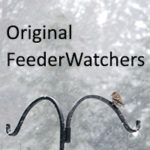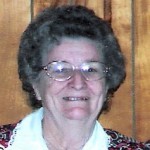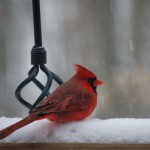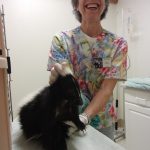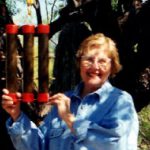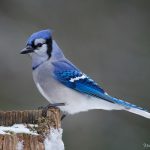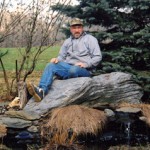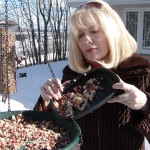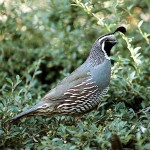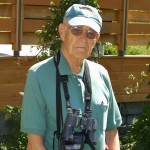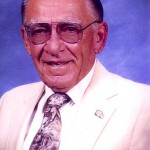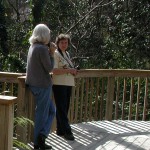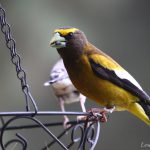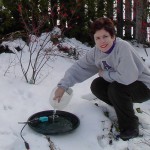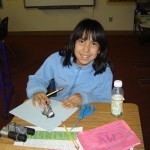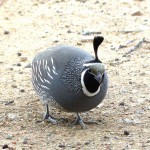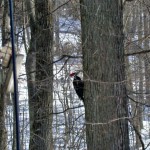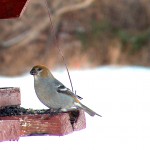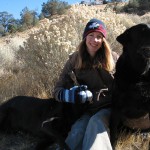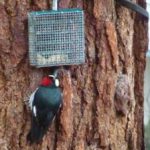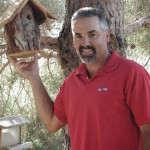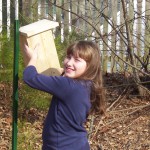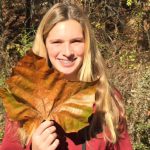Long-time participants
About Original FeederWatchers
In 2007, Project FeederWatch celebrated its twentieth anniversary, a milestone we can only attribute to the dedication and support of our devoted participants. At that time, 119 participants had been counting birds for Project FeederWatch since the very beginning in 1987. We wrote and asked them to share their FeederWatch stories. Scroll down to see quotes from some of the responses we received below. Click the thumbnails to the left to learn more some about some of these original participants. In 2017 when we celebrated our 30th anniversary, many of these committed participants were still counting!
John White of Excelsior Springs, Missouri, wrote, “I have always looked forward to participating in Project FeederWatch and have found it to be very enjoyable and educational. It is a good feeling to know that I have contributed at least a small part to the winter bird population data.”
After retiring and sadly losing his wife in July of 2002, John asked himself what is the one thing he would really like to do. His answer, “Get my degree!” In the 1950s, he attended the University of Missouri for four years, got married, got a job, and never finished. As of August 2007, he wrote to tell us he had two semesters and one summer course behind him and was eligible to earn a Bachelor of Science in Fisheries and Wildlife after his fall semester, at the age of 70! He says, “Next is graduate school and/or research work.”

Jamie Wright of Memphis, Tennessee, wrote, “I just enjoy seeing and hearing the birds. Winter would be dull and uneventful without them.”
Melanie Miller of Hays, Kansas, has a career in foreign languages and librarianship but says, “At one time, I wanted to be an ornithologist and later, a veterinarian.” Project FeederWatch allows “those of us who aren’t skilled enough to do this professionally” to be participants.
In addition to twenty years as a citizen scientist, Melanie holds two advanced degrees, a certification as a licensed bird rehabilitator, and is the author of “Birds: A Guide to the Literature,” which she partly researched at the Cornell Lab of Ornithology. She wrote, “I give you all this extraneous personal detail so that you understand how much it has meant to me to participate in Project FeederWatch for all these years.” Of all her achievements, she says, “I believe my proudest accomplishment is my certificate in Bird Biology from Cornell’s wonderful correspondence course.”
Barbara M. Souza of San Leandro, California, wrote, “As I reflect back on the past twenty years since I first answered an ad for Project FeederWatch that my husband found in a magazine, there have been many changes in our area, changes I probably would not notice otherwise.” Barbara says that her participation in Project FeederWatch has been a great learning experience for her grandchildren too. “They had a wonderful time ‘helping’ Grandma to count birds.”
Judith Anderson Thistle of Rochester, Minnesota, also enjoys watching birds with her grandchild: “The wonderful grandchild, almost nine, often visits for sleepover weekends. Our feeders, set on sweeps of lawn surrounded by woods abundant with acorns and wild black raspberries, attract Baltimore Orioles and Wild Turkeys, as well as deer–creatures he doesn’t see in the city.” Judith wrote, “FeederWatch–and our series of marvelous Alaskan Malamutes–have helped this non-native, survive our long Minnesota winters.”
Carl Woodward, Jr., of Highland Park, New Jersey, wrote, “For the last two or three years, a huge flock of robins (100+) has descended upon a holly tree adjacent to my lot. In a day they strip the tree of its ubiquitous berries. As they are busy stripping the tree, they become thirsty and drain my two bird baths in short order. This one-day feast takes place early in February each year. The birds behave in a frenzy-like manner. Very interesting to watch.”
Frances and Peter Mallet of Milton, Vermont, have seen many changes over the years. “When we started 20 years ago, the Evening Grosbeaks were consuming 50 pounds of sunflower seeds per week. Now it has been several years since we have seen even one.”
Dorothy Roes of Menahga, Minnesota, also noted the decline in grosbeaks. She wrote, “The one thing I really miss is seeing Evening Grosbeaks. When I started we would have over thirty on the feeders, but we have not seen one in over four years.”
Jane Haviland of Brunswick, Maine, wrote about her most memorable FeederWatching moment, which came during a 1998 ice storm: “With my first step out onto the deck, I was covered by a swarm of chickadees on my shoulders and arms and nuthatches on my head. That year, prior to the storm, I reported a high of 15 chickadees on my FeederWatch counts, but that morning 30 to 50 were all over me!”
Ann Plaisted of Ramsey, New Jersey, began watching and feeding birds with her family in the late forties after a chance meeting with “The Bird Lady of Tenafly, New Jersey, Betty Carnes,” who later became the first woman president of the Audubon. Ann says, “It doesn’t seem possible that Project FeederWatch is 20 years old (or that I’m 20 years older)!” The family hobby carried on to her grandparents in New York State, and now she says, “there are two younger generations who are interested. It’s a great hobby for all ages!”
M.W. Lewis, III, of Louisville, Kentucky, wrote, “I was at Cornell taking summer courses when Project FeederWatch was originated, and I have enjoyed it ever since. I have been a birder most of my life, and FeederWatch adds so much to the fall and winter months.”
Click the thumbnail images at left to see feature articles about more original FeederWatchers!
Alice Smith
Alice Smith has been interested in birds most of her life. She still has her first bird book from the 1950’s, and she has an extensive bird book collection with a few volumes from the 1930’s. Alice has been counting birds for FeederWatch from Florida for 20 years. For several years she lived in South Florida, but now she lives on five acres in McAlpin, Florida, a mostly wooded rural area in North Florida. In addition to FeederWatching, Alice monitors a Bald Eagle nest for Audubon Eagle Watch, participates in the Great Backyard Bird Count from two local parks, and participated in her first Christmas Bird Count this year as well as a county fall bird count.
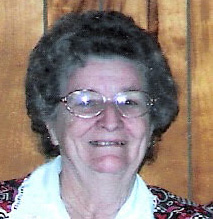
Feeding area
The National Wildlife Federation certified Alice’s yard as a backyard habitat a few years after she moved to McAlpin.
Alice has a sock thistle feeder, a tube thistle feeder, two seed feeders on posts, four hanging seed feeders, and from March to November, two hummingbird feeders. In addition to various seeds, she offers shelled peanuts and whole corn. She recently started putting out a dish of mealworms hoping for Eastern Bluebirds. She hasn’t attracted bluebirds, but an Eastern Phoebe enjoyed them for a few seasons. The Carolina Wrens and now a Northern Mockingbird enjoy the mealworms as well. Squirrels are a real problem so she puts safflower seeds for the cardinals in one of the post feeders that the squirrels can get on, since squirrels don’t like safflower seeds.
Feeder birds
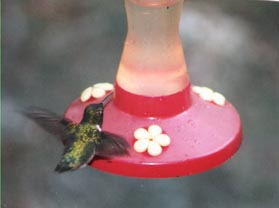
Alice wrote about her favorite bird, “my favorite is usually whichever bird is here, but I have to admit to really enjoying the Orange-crowned Warbler who has been coming regularly for awhile. When I lived in South Florida, I came home to find two White Ibis up in the pedestal birdbath.”
FeederWatching Tips
Alice offered the following advice for FeederWatchers. “First, enjoy yourself! If you are planting try to use native plants when possible. But have lots of flowers for butterflies and hummingbirds. If you are just starting, be patient; sometimes it takes awhile for birds to find the feeders.”
Arabella Tubbs
Arabella Tubbs has counted birds for Project FeederWatch from the same location in Maquoketa, Iowa, for 20 years. She always enjoyed birds but never had time to really pursue bird watching until she and her husband retired. That first summer after retirement, they cleared some land on a wooded part of her husband’s family farm. She wrote, “that entire summer it seemed I was kept company by many birds, especially an Indigo Bunting–a first for me.” The Tubbs’ retirement home sits 12 acres of second growth forest that has been used only as wildlife habitat and forest preserve.
In the past Arabella was a member of the Dubuque Audubon, and she continues to participate in the Christmas Bird Count and the Wildlife Conservation Board’s Sandhill Crane survey. Arabella has been on Elderhostel birding trips including a trip to Big Bend National Park in Texas, where she watched “Green Jays, Painted Bunting, Scaled and Harlequin quail, and too many hummingbirds to list!” She also traveled with Elderhostel to Winona, Minnesota, where she was able to view a Peregrine Falcon nesting on the bluffs above the Mississippi River. Arabella took a Smithsonian trip to the Bosque Del Apache National Wildlife Refuge in New Mexico, where she saw her first Golden Eagle. Just this past September, Arabella spent two weeks with an International Elderhostel at Aigas Field Centre in the Highlands of Scotland where she became acquainted with Scottish birds and enjoyed “fabulous field trips which stopped for all the birds!”
Feeding area
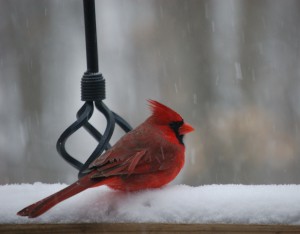
Arabella’s Count Site includes tube and platform feeders. She offers a single type of food in each feeder, usually nyjer, safflower, sunflower hearts, and black oil sunflower seeds. She also has a suet feeder and a heated birdbath during the cold months. Arabella watches her feeders from her kitchen windows, usually in the early morning, late afternoon, and again at twilight when, Arabella says, ” the cardinals are always the last to gather for a late snack.”
Feeder birds
Common birds visiting Arabella’s feeders in winter are goldfinches, chickadees, titmice, cardinals, Downy, Hairy, and Red-bellied woodpeckers as well as the ever present Dark-eyed Junco. Both Cooper’s and Sharp-shinned hawks occasionally visit. During the 2005-2006 winter, a Carolina Wren joined her feeder bird contingent for the first time.
FeederWatching Tips
Arabella recommends that FeederWatchers keep binoculars and bird guides handy and that they find birding friends they can call and consult when they are having trouble identifying a bird. She also suggested, “Never lose a sense of awe and wonder about birds.”
Barbara and Douglas Murray
Barbara and Douglas Murray of Santa Rosa, California, wrote to say, Project FeederWatch has been a particular delight to them:
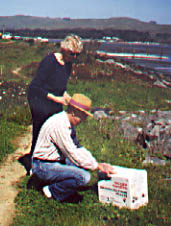
“We live in a retirement community surrounded by hills and state and county parks. Birding has been a very active hobby for my husband and me for over twenty years. Our location here has meant that visiting birds in our yard have been numerous and diverse. I’ve identified ninety species in our yard since we moved here in 1982.”
Beyond their backyard, the Murrays have a world bird list of over 1,126 species and spent ten years volunteering for their local Wildlife Rescue Center, picking up and delivering injured birds or animals to local veterinarians.
DJ Normark
Birding has always played a central role in DJ (Dorothy) Normark’s life. Growing up, her mother was a bird watcher and kept their backyard feeders stocked with seed. As soon as DJ owned her own home, she wrote, “Of course, I had to have feeders, too!”
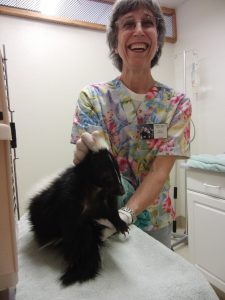
It was a natural fit for DJ to join Project FeederWatch. When DJ heard about a new citizen-science project starting at the Cornell Lab, she jumped at the opportunity. “I was watching birds at my feeders anyway, why not count them for science. Even when it isn’t Project FeederWatch season, I find myself counting birds.”
FeederWatch Count Site
DJ’s home in Sunnyvale, California, is bustling with birds and other wildlife. Her feathered visitors enjoy sunflower, safflower, and Nyjer seeds. Every morning DJ sprinkles the patio with sunflower seeds, “…partly to keep the squirrels away from the feeders on the other side of the house and partly to entertain my strictly indoor cats.” Along with nectar feeders, a grape vine and a persimmon tree attract birds that enjoy the sweeter side of life. “No one seems to care for the orange tree, but lots of the birds like the ripening persimmons, unfortunate for me, since I also like them,” DJ wrote.
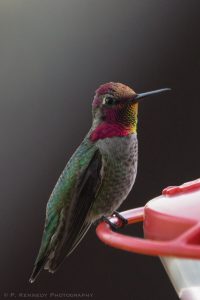
DJ’s feeder visitors include House Finches, chickadees, Lesser Goldfinches, titmice, towhees, juncos, Mourning Doves, White-crowned and Golden-crowned sparrows, Anna’s Hummingbirds, and an opportunistic Cooper’s Hawk. DJ was fortunate to have a pair of Anna’s Hummingbirds nest in her atrium and was able to observe the mother and her chicks up close. DJ even witnessed the mother showing the young how to eat from the nectar feeder.
Three birdbaths round out DJ’s count site. With California’s drought, providing fresh water is crucial. DJ wrote, “All kinds of wildlife come to my yard for the water. I’ve had raccoons, opossums, lots of squirrels, and an occasional roof rat, as well as lots and lots of birds (even though I’m on a small lot in the middle of Silicon Valley!).”
Volunteerism
In her retirement, DJ volunteers at the Wildlife Center of Silicon Valley, a non-profit facility that rehabilitates and releases native wildlife. “I’ve been able to hold, feed, medicate, and care for many types of birds, from common feeders birds, to vultures and Red-tailed Hawks,” DJ wrote. “Cooper’s Hawks and Red-shouldered Hawks are the most difficult to handle, but it’s a wonderful opportunity to see all of these birds up close. I’ve learned that baby juncos have their tell-tale (tell-tail?) white feathers almost before they have any other feathers!”
With a pair of small binoculars in her pocket, DJ is ready to bird at all times. Whether she is vacationing, running an errand, or at the kitchen sink, watching birds for fun, and for FeederWatch, is central to her life.
Jean Scheibe Smith
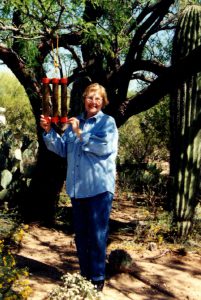
Some birders recall their “spark” bird—the one that grabbed their attention and forever changed the way they view the natural world. For others, birding is part of their DNA. For Jean Scheibe Smith of Tucson, Arizona, a bird walk opened her eyes. At that time, Jean and her husband lived near Cleveland, Ohio. They decided to join a walk led by Glen Kitson at North Chagrin Park and the rest is history. Jean wrote, “We were hooked!!! We enjoyed the walk so much we went right out and bought binoculars.”
Hooked on Birding
They proceeded to attend every bird walk they could. The couple moved from Ohio to Ontario to Michigan and finally retired in Arizona. In each new place, they quickly became active in bird clubs and the local Audubon Society.
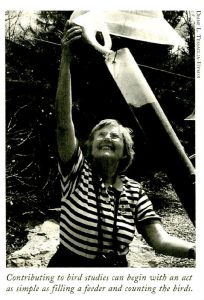
Jean’s birding experience is extensive. She banded the first House Finch seen in Michigan and has banded on Nantucket Island, Massachusetts, and at Tanque Verde Ranch outside Tucson, Arizona. For 15 years, Jean led walks in Sabino Canyon, a stone’s throw from her home. Jean has also mentored many birders, including two people who went on to become professional guides.
While Jean’s birding extends far beyond her backyard, her roots run deep with Project FeederWatch and the Cornell Lab. Jean’s daughter, Cyndy Scheibe, is a Cornell alumna and a professor at Ithaca College. “When visiting her, we always go to Sapsucker Woods and the Lab of Ornithology. As soon as I heard about FeederWatch I signed up,” wrote Jean. Thirty years later, she is still an active member of the Lab and FeederWatch.
FeederWatch Count Site
Jean’s count site sits at the edge of Saguaro National Park. Her yard features four hummingbird feeders, two suet feeders, two Nyjer feeders, orange halves, and a grape-jelly dish. Along the top of the brick wall, which partially encircles her yard, she scatters a mix of seed including black-oil sunflower, milo, and millet. She also has three birdbaths. Her feathered friends enjoy fresh seed, fruit, and water daily.
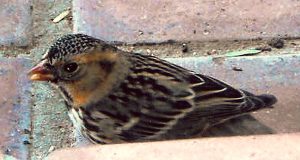
Frequent visitors to Jean’s count site include Lesser Goldfinches, White-crowed Sparrows, Pyrrhuloxia, Cactus Wrens, Abert’s Towhees, House Finches, Verdins, Mourning Doves, Gambel’s Quails, and Black-chinned, Anna’s, and Broad-billed hummingbirds. Jean’s favorite feeder visitor is the Rufous-winged Sparrow, and her most unusual visitor was a Harris’s Sparrow that overwintered in 2010-2011 at her count site.
Whether Jean is counting birds for FeederWatch, guiding hikes, mentoring new birders, or traveling, she is always on the lookout for feathered friends. Her “life list,” as of November 2016, is 729!
Jim Russell
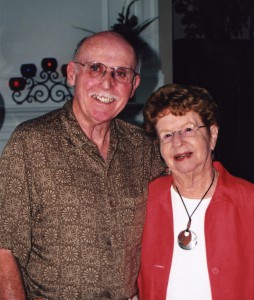
Jim Russell of Grand Prairie, Texas, started writing articles and columns for Nature Society News in early 2001. He wrote about his personal encounters “in the wild” in his column “Along My Path.” One of his articles described his FeederWatching experience better than we could. Here are excerpts of that article, which appeared in the May 2008 issue of Nature Society News.
Twenty Years in Cornell’s Project FeederWatch: A perfect fit for back yard birders
More than 20 years ago I saw an ad in a bird publication. Cornell University’s Lab of Ornithology and Bird Studies Canada were about to launch an enormous study of birds, their identification, numbers and movements, where they were and what they ate; how they were affected by weather—all that and more—and they needed my help and that of others. A daunting note was about the scope of their project; it would cover the entire North American continent. Wow!
Questions loomed. How could data I furnish from my tiny “spread” in Texas be of any help in something of such magnitude? Could it make a difference? My interest in birds has been lifelong; I was already a birder, and I write a monthly column about birds, but I was never involved in anything like this. I later learned that we would be among several thousand, continent-wide, submitting data; and among a couple hundred within our state.
A participant needed only a couple of feeders and some seed. This was in 1987, so let’s fast forward. Here we are, 20 years later, and in retrospect our experience has been totally positive. I said “our.” My wife Priscilla, a native New Yorker by the way, has been a constant partner as we gathered and contributed our data. Requirements have been basic. Our participation has been a joy.
We learned a few months ago that we were among 119 participants who have been submitting data since day one, so again, we had reason to be proud, both that our persistence had been acknowledged and to learn just a few of us had “stayed the course.”
Some might think that in counting birds and recording such data, we station ourselves, armed with binoculars and note pads, and stare, transfixed, at our terrain in a steady, interminable watch. In fact we report data at convenient times, recording actual time watched and the higher number of each species that we recorded on our designated days.
Assisting in a study like this offers the back yard birder an opportunity to “bird watch” in a casual, yet structured way. Structured does not mean regimented. Counts, and all that go with them, are done at the convenience of the participant, so there is no pressure.
We have lived here for 26 years, and among the birds we’ve welcomed to our feeders are Indigo Buntings. While they may have been here all the time, we saw them a couple of years ago at our feeders for the first time. Cousins of theirs, the Painted Buntings, have been sighted about four miles to the south of us, so some day soon we expect to see them at our feeders.
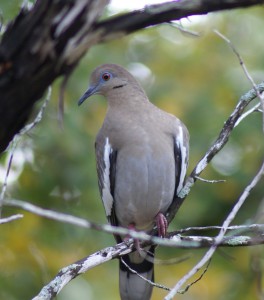
The single, most exciting, birds to become regulars in our yard are the White-winged Doves. Before my retirement, I was privileged to work both in northern Mexico and in six border counties in Texas. During those times I marveled at the White-winged Doves, along neighborhood streets, along roadways, and of course, in the wild, and I was envious of those who were about to enjoy these beautiful birds in those habitats. Gradually they have advanced northward, far beyond our location, and today their numbers in our back yard equal and often exceed those of our Mourning Doves.
It was our wish to share with you these notes as participants in Cornell’s Project FeederWatch. The Lab of Ornithology’s nurturing of the project has been constant, and such expertise has made the experience fun and worthwhile. We plan to continue.
Excerpts published with permission from Nature Society News.
Joshua Cutler
For Joshua Cutler of Washington, New Jersey, birding is a practice passed down from generation to generation. Joshua wrote, “I was born to a father who was an avid bird watcher, as was his mother. I imagine that my interest started before I learned how to talk, because my father was always pointing out birds and their songs.” When Joshua’s father heard about a new citizen-science project starting at the Cornell Lab, he signed up himself and his son to join Project FeederWatch.
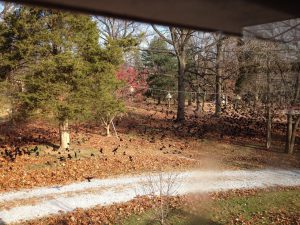
FeederWatch Count Site
Joshua and his wife Diana live and work at the Tibetan Buddhist Dharma Center (TBLC) located on 32 forested acres in eastern New Jersey. “I work where I live so I keep a constant eye on my feeder birds. Because I am used to seeing who is regularly there, I love how quickly I can spot an unusual visitor,” notes Joshua.
At the TBLC, bird watching is an interest and hobby shared with visitors far and wide. Joshua wrote, “We have hosted His Holiness the Dalai Lama here 8 times. He admired my feeder line because he feeds birds at his home in India!”
The feeder setup is designed to deter bears and squirrels. Joshua strung a long wire line between two trees. The line is roughly 10 feet high and contains a number of tube and suet feeders. Joshua keeps his feathered friends happy with black-oil sunflower seeds and suet. He also sprinkles the ground with cracked corn and millet. A birdbath on the deck and a kitchen window feeder allow Joshua and Diana to enjoy birds from a variety of viewpoints.
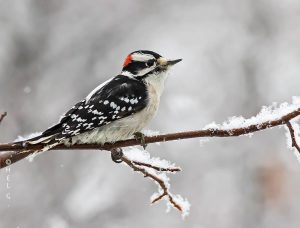
The feeders and birdbath attract a diversity of birds including Black-capped Chickadees, Tufted Titmice, White-breasted Nuthatches, House Finches, White-throated Sparrows, Dark-eyed Juncos, Blue Jays, and American Goldfinches. Red-bellied, Downy, and Hairy woodpeckers also frequent the count site along with the occasional Sharp-shinned, Cooper’s, and Red-tailed hawks. In the last 10 years, Joshua and Diana also have had the privilege of seeing Evening Grosbeaks.
Always Birding
In addition to being a member of FeederWatch, Joshua participates in two different Christmas Bird Counts, a century old annual count run by Audubon. He also participates in the World Series of Birding conducted by New Jersey Audubon every May. “Otherwise,” Joshua wrote, “I am always birding. I just love birds and seeing them wherever I go.”
Mark Chestnut
Self-proclaimed “birdaholic,” Mark Chestnut of Shoemakersville, Pennsylvania, says he looks forward to what each year might bring to his feeders and calls it a “treat” to be one of the original FeederWatchers.
“I have many many memories,” he told us, some of which he calls, “close encounters of the bird kind.” One encounter occurred while watching Eastern Kingbirds swoop in for insects one morning: “I had a tube feeder in one hand and the new one in the other, a Red-breasted Nuthatch landed on the old feeder to take a sunflower seed, paying no mind to his food supplier for that moment…I can’t put into words how much I love this hobby of birding.”
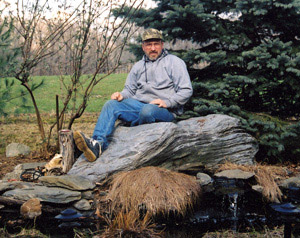
Mark says, “I guess you can call us the passenger pigeons of the program. In the far away future we will be extinct, but I hope we can set an example for birders helping citizen science projects.”
As he wrote to us, he watched a Carolina Wren collecting bugs five feet from his toes on his deck. “It’s moments like this that are so precious,” he wrote. “I’m proud to support Cornell. It’s a pleasure just to be a small part of a wonderful project like FeederWatch.”
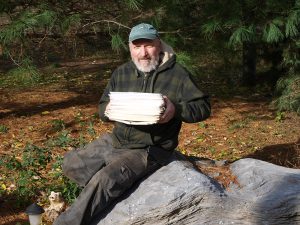
Update fifteen years later
This participant feature was written in 2001, when FeederWatch was celebrating its 15th season. That season, we featured a number of our original FeederWatchers. In November 2016, at the start of our 30th season, Mark posted this photo in the FeederWatch Participant Photos Gallery. The photo was taken in the same spot in his yard as the photo he provided for this feature 15 years earlier. As FeederWatch celebrated its 30th season and its first season with all online data submission, Mark posted in the caption of his photo that, “the paper was getting too heavy.”
Mary Strasser
Mary Strasser of Onalaska, Wisconsin, started Project FeederWatch as a young woman in her early thirties and says her love of birds and appreciation of the natural world has grown over the years since becoming a participant.
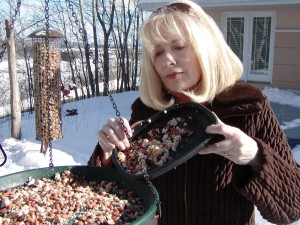
“I must say…the greatest reward for me as a participant in Project FeederWatch these many years has been observing birds and bird behavior I might have missed had I not been part of this project.”
After twenty years, Mary is still FeederWatching and encouraging others to participate:
“Nature observation can be such a rewarding activity, and it can be done over a lifetime, virtually anywhere outdoors, and very inexpensively. I would like to see more people, particularly children, become infatuated with an introduction to the natural world as I have. I think ‘citizen science’ projects offered by the Cornell Lab are an excellent way to spark a lifetime involvement with nature.”
Mimi and Ellis Myers
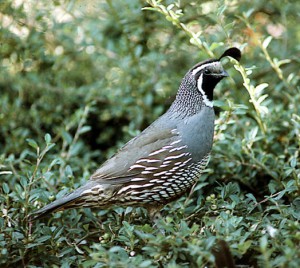
Mimi Myers first became interested in birds 1956 while at home with a new baby. A Wrentit frequently foraged under an azalea just outside their bedroom window. Curious about the identity of the bird, Mimi asked her sister. Shortly after, Mimi’s mother gave her a Peterson’s guide, and she and Ellis began feeding birds.
In 1990 Mimi and Ellis retired after running a scientific illustration business. Prior to the family business, Ellis worked for the University of California as a chemist and illustrator.
FeederWatch Count Site
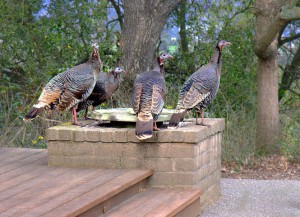
For Mimi and Ellis, FeederWatching is a joint effort. They have lived in the same location in Moraga, California, since 1973. The yard has native Valley Oaks and Live Oaks, and the Myers planted redwoods and alders that are now mature. The yard is registered with the National Wildlife Federation as a Backyard Wildlife Habitat.
The Myers have two hummingbird/oriole feeders, two sunflower chip feeders, a peanut feeder, and a hanging saucer for peanut butter. They mix peanut butter with flour so that it crumbles, preventing jays from taking more than their share at one time. They spread corn and millet along an extended strip on the ground to make it easier to count large numbers of sparrows and towhees. They also have a large bird bath with bubbling water.
Lab researchers tested their House Finches
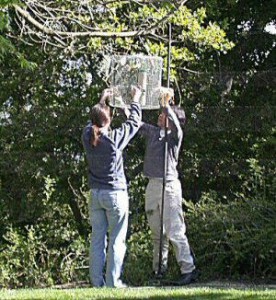
The Myers have hosted a large group of House Finches over the years and sent their counts to Project FeederWatch. Consequently, when researchers at the Cornell Lab of Ornithology were looking for a location to find a western population of House Finches, they contacted the Myers. In 2004 researchers came to the Myers yard to capture House Finches and take blood samples. The Myers wrote of the experience, “We welcomed the researchers for a day in the backyard and were surprised that they were able to capture 42 individuals for sampling, where we might have expected 15 or so.” You can learn more about the research in the March 2006 issue of the Quail (pdf, scroll down to page 4), the Mount Diablo Audubon Society’s newsletter, which Ellis edits.
Rare birds
In addition to common birds, the Myers have hosted some rare birds over the years. In 1975 a Ring-necked Pheasant visited for two weeks; their millet attracted a Lark Sparrow in 1997; and the sunflower chips feeders hosted a Rose-breasted Grosbeak in March, 2000, and a Cassin’s Finch in June, 2002.
One last thought
When asked if they had any parting words for their fellow FeederWatch participants, the Myers wrote, “Learn to love the squirrels, who will outwit you whatever you do, and the brush rabbits, who will eat your lawn instead of the grain.”
Rene Prochelle
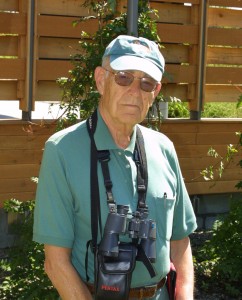
Rene Prochelle of Port Chester, New York, is one of Project FeederWatch’s first participants, joining in 1987. He was born in Chile and has been interested in birds since he was young. He said, “I saw my first Andean condor sail over the peaks of the Andes. No word to describe it. That did it.” He read about Project FeederWatch in Bird Watchers Digest and liked the idea of doing something for birds while also learning about them.
In 2004, Rene came to Ithaca, New York, to visit the Cornell Lab of Ornithology’s new building. While he was here, he visited with FeederWatch staff and was photographed in the Lab’s feeder garden (left).
Rene is now retired after working for 41 years in international transportation (steamship lines, cargo ships). He found this work facinating as it gave him the chance to see various places throughout the world.
Living in a suburban home with a large hemlock hedge in back, Rene watches his feeders through a large cathedral window in his dining area. He wrote, “I have a sheltie that always comes with me. She has graduated from bird chaser to reluctant bird watcher!”
Feeding area
Rene has two suet cages, three nyjer seed feeders, two mixed-seed feeders, four black-oil sunflower feeders, and two bird baths.
Favorite bird
Although Rene likes all birds, he is especially fond of the Black-capped Chickadee because it was the first bird that came to his feeders on his first FeederWatch day.
Observing local trends
According to Rene’s own statitistics, from the 1989–1990 FeederWatch season through the 2003–2004 season, House Sparrows were his most abundant feeder visitor, followed by slate-colored Dark-eyed Juncos. But House Sparrows have been declining the last three years and juncos are now number one in abundance in his yard, followed by American Goldfinches.
Roger Simms
Not only has Roger been participating in Project FeederWatch since it began in its current form, but he participated in the Ontario Bird Feeder Survey for 5 years before that. In 1976 the Ontario Bird Feeder Survey was created by Erica Dunn at what was then Long Point Bird Observatory (now Bird Studies Canada). In 1987 the survey was expanded and turned into Project FeederWatch (learn more about the history of FeederWatch). Roger joined the project in 1981 after being introduced to it by a cousin.
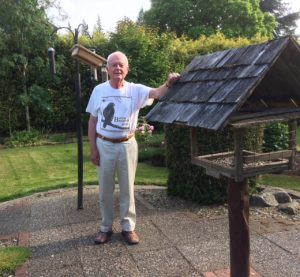
Lifelong birder
Birding has always played a role in Roger’s life. Several people fostered his interest in birds when he was growing up in England: a family friend who took him on nature walks in the park on Sunday afternoons, a grandfather who pointed out birds, and his mother who bought him a bird book. After moving to Canada when he was 26, he enrolled in a bird identification course and his interest in birding flourished.
Count site
His Feederwatch location has changed three times over the years—from southern Ontario to Northwestern Ontario to his current location in Parksville, British Columbia. Roger has a number of feeders, including a homemade platform feeder and two hummingbird feeders. He keeps his feeders filled with suet, peanut halves, a mix of sunflower chips and nyjer seeds, and a seed mix from a local bird store. He also provides water. His site is at the edge of a suburb close to lots of conifer trees as well as deciduous and cedar hedges.
Feeder birds
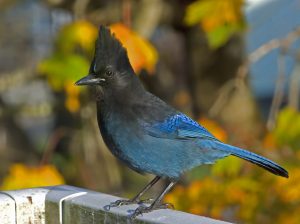
Roger usually sees between 8 and 17 species including finches, sparrow, woodpeckers, Eurasian Collared-Doves, California Quail, Stellers’s Jays, and Northern Flickers, plus Sharp-shinned and Cooper’s Hawks. He doesn’t have any favorites, but his most common is Dark-eyed Junco, his most unusual is Northern Shrike, and the first bird he usually sees on his counts is Anna’s Hummingbird.
Other bird-related activities
Roger has participated in the Great Backyard Bird Count, Great Canadian Birdathon, and Coastal Waterbird Surveys. He has led bird outings for Arrowsmith Naturalists, Brant Goose Surveys (bi-weekly February through April), and Brant Wildlife Festival in March and April. And he goes birding on his own most Sundays.
The value of FeederWatching
Roger likes to see what birds are visiting his feeders, and he likes knowing that his observations are helping researchers. He noted that it can be as expensive or as inexpensive as you want. “It is an easy hobby. Just watch birds at your feeders over 2 days…. I really enjoy it,” he wrote.
Vernon Dayhoff
Bird Man of Gleneagle
It is no wonder that Vern Dayhoff has been called the “bird man of Gleneagle” by his local newspaper near Colorado Springs, Colorado. A lifelong birder, Original FeederWatcher, and author of a birding book and several magazine and professional journal articles, this retired biology teacher has visited every continent on the planet, adding more than 3,141 species of birds to his life list.
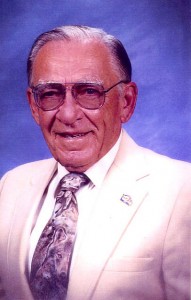
Migratory Birder
As a long-time member of the Cornell Lab of Ornithology, Vern learned about Project FeederWatch when it first launched in 1987 and has been participating ever since.
Over the years, he has given numerous lectures on birds, has participated in Christmas Bird Counts with the Audubon Society in Hawaii, California, Arizona, and Colorado, and he was featured in The FeederWatcher’s Guide to Bird Feeding by Margaret A. Barker and Jack Griggs.
Vern has been all over the world building an extensive library of books and photos of the birds he has seen, while spending his summers traveling on Nature Tours with his wife, Georgia.
Of all the birding spots he’s visited, this world traveler’s favorite place to watch is from his den in Gleneagle, overlooking a wild bird sanctuary that he and his wife built on five acres around their home. In 2000, their backyard was featured in the December issue of Birder’s World.
Backyard Bird Sanctuary
In the late 1960s, when Vern and his wife moved to their home near Colorado Springs on five sparse acres in rural Gleneagle, they set out to create their bird sanctuary. As a biology teacher, Vern was interested in learning about native trees and wanted to plant varieties in his yard that would attract an array of species. In addition to a scrub oak and some prairie short grass that grew there, Vern and Georgia planted an assortment of saplings that have since become a flourishing forest of pines that offer seed crops and shelter, including Colorado blue spruce, Douglas and white fir, pinion pine, Rocky Mountain juniper, as well as several native fruit trees.

In The FeederWatcher’s Guide to Bird Feeding, Vern describes planting a ponderosa pine every twenty feet or so, making a “flyway” between the forest and his feeding area to encourage shy birds, such as nuthatches and chickadees, to visit the feeders. Vern provides trees, shrubs, rock piles, and brush throughout his yard to create natural shelters for birds that come to his feeders. “Evergreens,” he says, “are ideal, providing maximum cover from winter winds and predators.”
An eight-foot dead pine tree serves as the center-piece of Vern’s feeding area, featuring hanging homemade bird feeders and holes in the pine filled with beef or peanut butter suet.
High-energy foods, such as peanut butter and beef suet, attract insect-eating birds, such as chickadees, woodpeckers, and nuthatches to Vern’s yard. Birds that live in cold climates, he says especially appreciate these high-energy foods. To eliminate the risk of birds choking on sticky peanut butter, Vern mixes in yellow corn meal and a few ounces of white millet, nyjer thistle seed, black-oil sunflower seeds, and cracked corn.
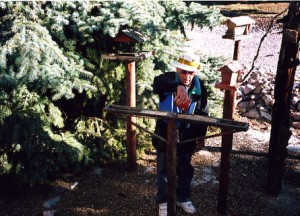
In addition to several hopper feeders outside of his den window, Vern has a four-foot-long tray feeder that offers separate sections for black-oil sunflower seed, cracked corn, and a mix of thistle seed with ground eggshells, “so I could see for myself which birds like what seeds,” he says.
Providing a variety of food types may help to attract different species to your feeders, Vern suggests, “but that doesn’t mean you need to purchase one of everything on the shelf.” In fact, he says, “Several studies show that the high-energy food black-oil sunflower seed is the flock pleasing favorite of the majority of birds.” If you fill a feeder with a standard mix of sunflower, milo, millet, oats, wheat, flax and buckwheat seeds, he says, “you’ll see many birds actually kicking out the smaller seeds to get the prized sunflower seeds.”
Sturdy feeders that can withstand winter weather and are tight enough to keep seeds dry and large enough that you don’t have to fill them constantly work best, he says, and according to Vern, “Plastic feeders work better than wooden ones.”
For the ground-feeding birds, he offers white millet, cracked corn, and black-oil sunflower seeds on a sheet of plywood that is sheltered by a Douglas fir tree. For finches, tube feeders hang outside of his kitchen window filled with black-oil sunflower and thistle seeds.
A heated bird bath offers a year-round water source for birds to drink and bathe in Vern’s yard. “Providing water in winter is just as important as feeding the birds,” Vern says, because “unfrozen water can be as hard for birds to find in winter as food.”
Even with hundreds of new houses going up just miles from their home, the Dayhoffs have managed to preserve their quiet sanctuary for a variety of birds and other animals.
Winter Bird Feeding
According to Vern, “If you feed birds, you are in good company,” since he says birding as a hobby stands second only to gardening as America’s favorite pastime, both of which benefit the birds. Winter, especially, he says is a difficult time for birds: “Days are often windy and cold; nights are long and even colder.” Setting up a backyard bird feeder, he says, makes birds’ lives easier and more enjoyable.
As a veteran birder, Vern has written several articles about bird feeding and the etiquette of bird watching. In an article he wrote called “Good Birding Behavior,” Vern emphasizes that the safety and well being of birds is top priority. “Birding is most enjoyable when the birds can be observed going about their normal activities,” he wrote, “Agitation, repeated alarm calls, aggressive behavior, or distraction displays are all signs that we are too close.”
As for his FeederWatch routine, Vern says, “I watch my feeding area every opportunity most every day all seasons of the year. My feeding area is kept clean, feeders full, fresh water given every evening for early birds for the following day.”
Common Feeder Visitors
During the winter months, Vern’s backyard sanctuary attracts a wide variety of species. The most common visitors include: Sharp-shinned Hawks, Cooper’s Hawks, Mourning Doves, Downy Woodpeckers, Hairy Woodpeckers, Northern Flickers (Red-shafted), Steller’s Jays, Blue Jays, Western Scrub-Jays, Black-billed Magpies, American Crows, Black-capped Chickadees, White-breasted Nuthatches, Pygmy Nuthatches, American Robins, European Starlings, Spotted Towhees, White-crowned Sparrows, Dark-eyed Juncos (White-winged, Slate-colored, Oregon, Pink-sided Oregon, and Gray-headed Rocky Mountain races), Red-winged Blackbirds, House Finches, Pine Siskins, American Goldfinches, and House Sparrows.
According to Vern, the most unusual birds at his feeders are Western Tanagers, Rose-breasted Grosbeaks, Red Crossbills, and Common Redpolls: “only once in my 40 years I have seen one Common Redpoll.” Turkey Vultures, Red-tailed Hawks, and Northern and Loggerhead Shrikes visited his feeders a few times.
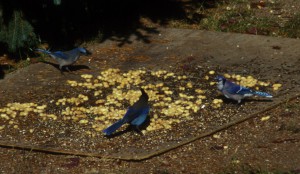
One of Vern’s favorite and most memorable FeederWatch photos captures a Steller’s Jay, a Western Scrub-Jay, and a Blue Jay eating together. Scrub-Jays and Steller’s Jays are common in his area, but a true Blue Jay-usually seen mostly in the east-is a treat.
According to Vern, “You won’t find another photo in the world like that.”
Of all the feeders birds that visit his count site, Vern has a soft spot for a migratory species that has opted to stay at his backyard sanctuary all year long:
“My favorite feeder bird is the Spotted Towhee. It is normally a migratory bird, but I have one or two male birds that stay at my feeding area all seasons of the year. During cold and snowy weather, they stay in and under the large blue spruce tree near the feeding area and only come out long enough to feed and go right back under the tree.”
Birder from the Beginning
Vern attributes his interest in birds to his mother, who taught him an appreciation for nature as a young boy growing up in York, Pennsylvania. In the years that followed, he says he had little time to pay much attention to birds, though his passion for nature only grew.
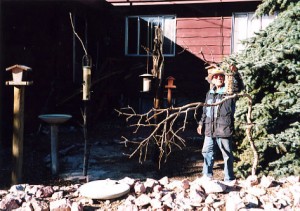
Over twenty-two years of experience in the U.S. Air Force, traveling the world and teaching as an instructor at the Air Force Academy eventually inspired Vern’s career in education.
In 1962, he was awarded a Bachelor of Arts degree and shortly after, retired from the Air Force. After earning his teaching certificate, Vern went on to teach high school biology for twenty-one years in Colorado Springs, where his honor students nominated him in Who’s Who Among America’s Teachers in the 6th and 9th editions. According to Vern, only five-percent of our nation’s teachers are honored in each edition of Who’s Who, and less than two-percent are included in more than one edition.
“As a trained teacher, I can tell you that the personal experiences I’ve had with birds are more valuable than any book learning I’ve ever had.” –Vern Dayhoff, The FeederWatcher’s Guide to Bird Feeding
More Featured Participants
Anne Coffey
A tale of two count sites
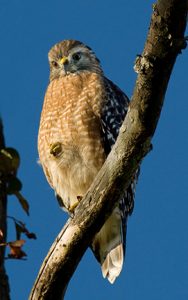
Anne Coffey started FeederWatching in 2013 with an active count site in a place one would expect to see few birds—Tysons, Virginia, a densely populated area near Washington, DC. Her site was surrounded by high-rise buildings and within walking distance from a large shopping mall. Nevertheless, she hosted a busy feeder station and saw as many as 17 different species and 49 individual birds during one count. She wrote, “When I put out my feeders for the last FeederWatch season there, my first visitor was a Red-shouldered Hawk, which sat in a nearby tree waiting for the songbirds to arrive. After two unsuccessful hours, the hawk left, and songbirds began to visit.”
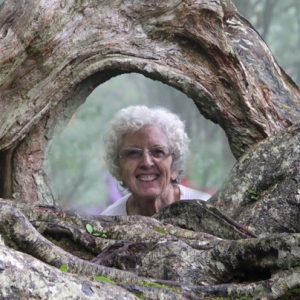
Then in November 2017 Anne moved to Asheville, North Carolina, and started her fourth FeederWatch season. Her new neighborhood did not permit seed feeders, so she hung a suet feeder and a fruit feeder above a berry-laden holly bush. In December, after doing two counts with no birds, she wrote to FeederWatch to say that although she had seen Carolina Wrens and American Robins close by, no birds were coming to her count site. She asked, “Should I continue with this exercise when I may not get any birds visiting? It seems like a waste of your time having to include zero counts.”
We assured Anne that the absence of birds is just as important to our data as the presence of birds, and we encouraged her to keep counting. Although Anne’s low counts could be attributed to the lack of seed feeders, having data from sights with no seed feeders allows researchers to assess the impact of seed feeders on winter feeder-bird populations.
Anne went on to watch her feeder area for 6 more counts before observing any birds despite watching at all times of day and watching the feeders for 1–4 hours during most of the two-day counts. She found the observations especially discouraging, because she was working part-time at a Wild Birds Unlimited store and was hearing customers share their exciting sightings. She wrote, “It’s definitely not as much fun to get so little traffic, but it helped to know it was worthwhile.”
Finally on her 9th count that season, she observed two chickadees, and additional birds starting visiting after that, including a Northern Mockingbird, a species that is notoriously territorial, especially when protecting a fruiting shrub like holly. She ended her first season having observed no more than 5 species and 6 individual birds in any one two-day count. Undaunted, Anne counted for a second year in North Carolina and was rewarded with 14 individuals from 8 species on her first count. Her counts dipped from there, but she continued counting through the season.
More recently Anne moved to Manlius, New York, where she was able to include seed feeders in her count site again, and not surprisingly, her counts grew to as many as 14 different species and 28 individual birds during one count in the spring.
FeederWatch wants all counts
In addition to wanting counts when few or no birds are seen, researchers want counts of common species. It’s more fun to watch feeders when a variety of birds are visiting and visiting in large numbers, but having more or different birds to count has no effect on the value of your data to researchers. As described in an article in the Learn section of our website, years ago in Great Britain, researchers considered House Sparrows as nuisance birds and didn’t track their populations. More recently people started noticing fewer House Sparrows and as researchers began to assess House Sparrow populations and look for reasons for the decline, they regretted that they had neglected to collect House Sparrow counts for decades. Thanks to FeederWatchers like Anne who keep counting even when they see the same birds every week, or when they see no birds, we are able to assess population trends in all winter feeder birds.
David Smith
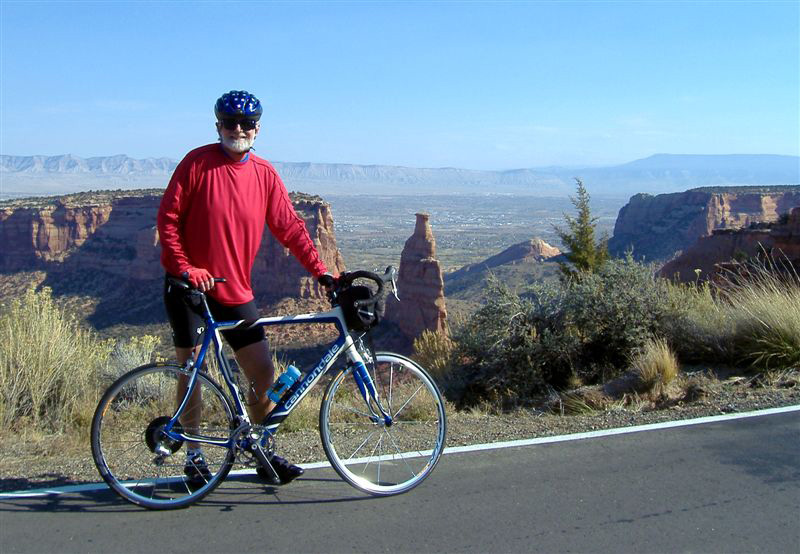
David was first introduced to birds back in the 50s when his parents bought a Peterson’s guide. Later, when he was in medical school and considering a residency in radiology, David’s advisor recommended that he take up bird watching because “it will teach you to recognize the important details within the background clutter.” After medical school, David focused on his career and on raising a family until about ten years ago when he and his wife, Shanna Rendon, set up feeders and began visiting their local Audubon sanctuary. Their son, Casey, encouraged David to return to his interest in photography. That’s when David began photographing the birds coming to his feeders. Now he is retired and has more time to pursue his photography as well as skiing and bike riding.
FeederWatching
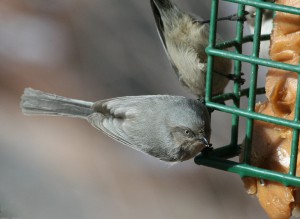
With binoculars and camera nearby, David and Shanna watch their birds for about an hour each morning from two chairs near their picture window while drinking coffee and tea and discussing their plans for the day. The window overlooks high desert, shale hills, and gneiss and sandstone cliffs as well as their feeder station, which is just outside the window.
“We get a kick out of the Bushtits, but we have to be at the window at just the right time because the flock arrives, eats, and leaves in about a minute.”
Shanna is the better “spotter” says David. “With 30 years of experience in a hospital lab, most of that as a cytotechnologist (looking at specimens trying to distinguish the few malignant cells from the other 200,000 to 400,000 normal cells on a slide), she is detail oriented and can spot a small variation in color, size, or form marking an unusual bird that I might miss.” David and Shanna regard their careers “studying slides and x-rays as good training for the more relaxing pursuit of counting birds for FeederWatch,” David wrote.
Habitat
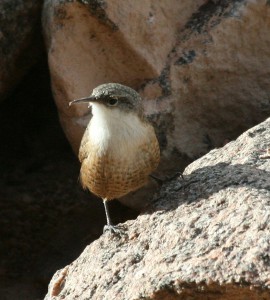
David and Shanna first started FeederWatching in a lower, marshy woodland area about two miles away from their current home. Despite the close proximity, the habitat changed drastically when they moved about two years later to their current high desert location with pinyon pines and junipers. They found that far fewer common feeder birds, such as sparrows, chickadees, and titmice, visit their current site than their previous site, but they now are treated to Canyon Wrens, Pinyon Jays, and Gambel’s Quail.
“Our feeder station is bounded at the back by a stack wall of boulders, and this little guy was exploring all the cavities.”
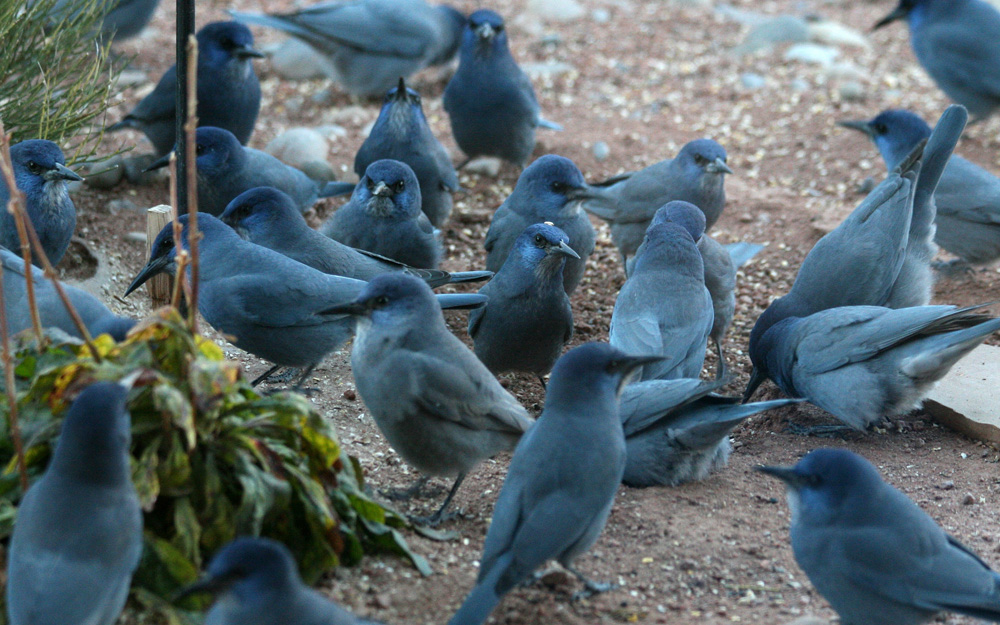
Their current yard borders the Colorado National Monument on the western slope of the Rockies, near Utah, where the mountains meet the desert at about 5000 feet. An old buffalo fence marks the boundary to the monument—a remnant from the days when buffalo roamed this portion of the park. David described the front yard as suburban, with a sidewalk and people walking by, while the back is wide open and natural.
The temperature range from summer to winter is drastic, with extremes as high as 105 degrees in summer and as low as 0 degrees in winter. They only receive about 9 inches of precipitation each year. Consequently the plant life is sparse and lacks variety, which limits the number of bird species that visit the feeders.
The birds
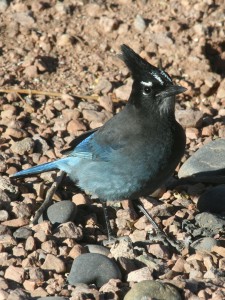
The most common bird at David and Shanna’s feeders is the junco, but the species with the biggest flock size—up to 100 at a time—is the Pinyon Jay.
Other common visitors include Gambel’s Quail, Western Scrub-Jay, Bushtit, House Finch, Mourning Dove, and American and Lesser goldfinches. Cooper’s and a Sharp-shinned hawks also patrol the feeders daily.
At one point David and Shanna had three kinds of jays in a ten minute period—Steller’s Jay, Pinyon Jay, and Western Scrub-Jay. David was especially delighted to see the Steller’s Jay, which he used to see when he lived in the Santa Cruz Mountains in California, but this species rarely descends to the elevation of his current home. He also noticed that the Steller’s Jays he has visiting now have more white around the face and over the eyebrows than the birds he saw in California, indicating that he is now seeing a an interior form of the species, which made the sighting even more exciting.
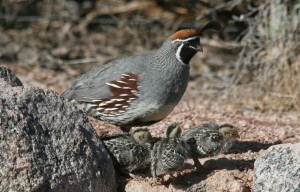
David’s favorite feeder visitor is the Gambel’s Quail. “We are on the Quail Parkway, used daily as the Gambel’s Quail commute from an adjacent arroyo to a large grassy area on the other side of the buffalo fence,” David wrote. In the spring, the quail bring their chicks to David’s window, up to sixteen in a clutch. “In the winter, they wade through the snow and toboggan down the slope to the feeding area.”
A couple of years ago David and Shanna hosted two Orange-crowned Warblers for several months. The species had never been reported in the Grand Valley during the winter.
Feeders
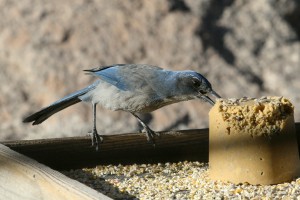
David and Shanna have tube feeders filled with nyjer seed and sunflower chips (David says he doesn’t like the mess of oiled sunflower seeds); platform feeders for chips, cracked corn, and peanuts; and a suet cage for peanut butter. On the ground they spread corn, sunflower chips, and peanuts. David makes homemade suet blocks from lard, peanut butter, cornmeal, flour, and seed that he forms into blocks and puts on his platform feeders. The feeder area also includes a heated bird bath.
“These guys can clean out the tray in a matter of minutes commonly packing three nuts in their crops while carrying two in their beaks.”
Debra Tyre
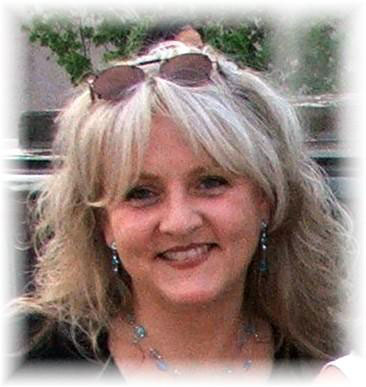
As an artist, Debra Tyre has always been a nature and wildlife buff, so it was not surprising that her children gave her a bird feeder in 2004, a gift that enhanced her love of nature-journaling, photography, and art. Little did she know her new feeder would be the beginning of her “bird watching adventure.”
In January of 2005, an unlikely ice storm swept through Debra’s hometown of Norcross, Georgia, and brought with it a new visitor to her backyard—a Pine Warbler! Debra first noticed the bird singing in nearby pine trees as she filled the feeders each morning. Then one day, while putting out mealworms for the area bluebirds, she was surprised to see him land on the deck only a foot from where she stood.
Nearly every morning for the next two months, the Pine Warbler sang from the trees waiting for Debra to come out. Then, eventually he came knocking! Fluttering his wings at her sliding glass doors, he knocked as if to say, “I’m here! Come feed me!”
By the end of March, the warbler had stopped coming for his morning visits, and Debra assumed he had moved on. Then, to her surprise one rainy morning the following December, he knocked again. “Imagine my genuine amazement!” Debra wrote.
Memories of a Bird Garden
Debra grew up in a rural area of Michigan’s Lower Peninsula and fondly remembers visits to her grandparents’ home in the nearby small town of Mason where she first fell in love with watching birds. Once a week, her grandmother, Amber Hart, baked bread and filled her kitchen table with a collection of homemade butters, jams, and jellies.
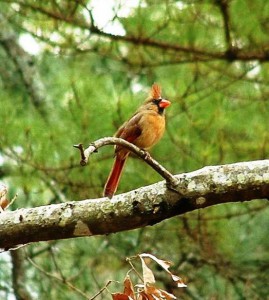
On “bread day,” as Debra called it, she and her mother would often visit to eat warm bread slathered in jam and stroll through her grandmother’s bird garden. Debra wrote, “It wasn’t much to look at for most, but to my childish eyes, it was a lovely sanctuary.” Bird baths were the focal point of the garden, which Debra described as “Back-dropped by tall dark conifers, a few scattered rosebushes and flowers, and nearby patches of various berries from which she drew her jams.” There, she enjoyed watching the Northern Cardinals, crows, and other songbirds “swoop down, dance in mid-air, and play.”
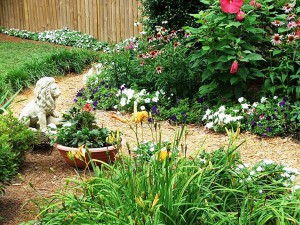
Though Debra says she didn’t truly appreciate the influence of growing up in a rural, small town community at the time, in recent years as a photographer, artist and homeschool parent, she has come to value how her eyes were “trained to see differently.” She wrote, “As a budding child artist, I learned to appreciate the natural world largely through experiences such as these mornings spent in Grandma Hart’s bird garden.”
Debra has passed her love of nature on to her own children over the years through various hikes, wilderness ventures, field trips, and visits to wildlife sanctuaries. In 2004, she was delighted when her children gave her the bird feeder, along with The FeederWatcher’s Guide to Bird Feeding, featuring a bright red male Northern Cardinal on its cover, a reminder of her favorite childhood memories. Debra wrote, “I think I was hooked before I ever opened the book, and I inhaled the entire book, cover-to-cover, in a single afternoon!”
FeederWatching in Georgia
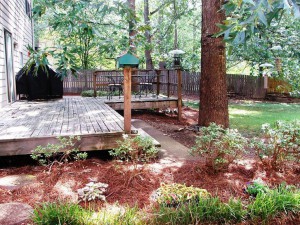
Debra’s current home is in a suburban neighborhood known as Peachtree Corners, which is cornered by the bends of Chattahoochee River and Peachtree Parkway, about twenty miles north of Atlanta.
Situated in a 25-year old subdivision with mature flora and fauna, her property consists of a combination of landscaping, lawn, and woods on ¾ acre of land and is surrounded by a diversity of trees. Debra wrote, “We have a wild and overgrown Cherokee Rose (bush) along our back fence, which has become a haven for the more timid birds such as Brown Thrashers, Eastern Towhees, Dark-eyed Juncos, and migrant White-throated Sparrows.”
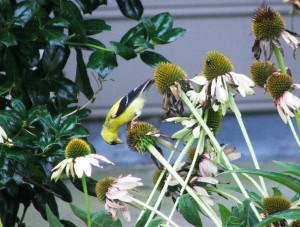
More recently, she’s planted bird-friendly perennials that she says have attracted “several sunny yellow American Goldfinches” that hang upside down to eat from the cone flowers in her garden.
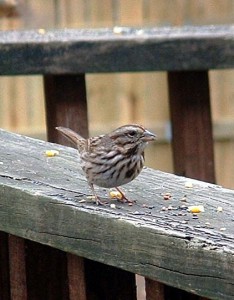
Debra’s daily routine includes scattering a white millet-black-oil sunflower mix on the ground for towhees, thrashers, sparrows and juncos and a corn-peanut-sunflower mix for blue jays, northern flickers, chipmunks, and squirrels. When it gets colder, she also scatters the millet mix on her deck rail and puts out fresh water each day on her “deck-attached bird bath.”
Early to mid-morning and the early afternoon around lunch are her favorite times to watch from her large sliding doors and windows that overlook her deck.
Squirrel Revenge
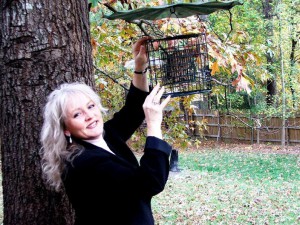
“Gray squirrels, and sometimes raccoons and opossum, are nothing short of obnoxious where we live,” Debra told us, “and the wildlife has effectively destroyed four tube and three suet feeders over the past few years.” Fortunately, she says she has found some solutions, including an eight-foot backyard fence, rodent-resistant feeders, and bringing in her suet at night.
Homemade Blends
Debra enjoys experimenting with custom blends of bird seed for every season. For example, she says, “Nyjer, black-oil sunflower, and white millet is standard summer fare, while in the winter months safflower, peanuts, milo, sunflower hearts, and dried fruits (raisins, cherries, cranberries and dogwood berries) are added.” From fall to spring, she provides live mealworms for the Eastern Bluebirds and various warblers, but “only a handful each day,” she says, “because the Carolina Wrens are a bit piggish and will otherwise quickly deplete my supply.”
According to Debra, the “biggest hit” is her homemade suet, invented from recipes found in The FeederWatcher’s Guide to Bird Feeding and “three years experience.”
The Birds
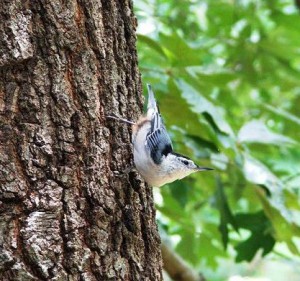
When asked about her favorite feeder bird, Debra wrote, “That’s a tough call,” as she tends to love all brightly colored birds and says she is fortunate to have so many in Georgia. Narrowing it down by season, she wrote: “In the winter, I guess that would be the Yellow-rumped Warbler; in spring, the American Goldfinch; in the summer, the Eastern Bluebird, and in the fall, the Northern Cardinal.”
Debra’s most common visitors include Carolina Wrens, Carolina Chickadees, White-throated Sparrows, White-breasted Nuthatches, Brown-headed Nuthatches, Eastern Bluebirds, and Downy Woodpeckers. Last winter, she saw some unusual birds in her yard, including a Cedar Waxwing that stopped by for a drink and her family’s first Yellow-bellied Sapsucker, which she says was “an oddly-marked juvenile which took two days to identify and who stayed until breeding season began.” This year’s newcomers have included a Cooper’s Hawk, Red-shouldered Hawk, Red-breasted Nuthatch, and a small flock of Red-winged Blackbirds.
FeederWatching Tips
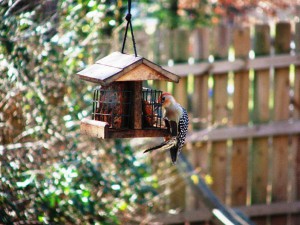
According to Debra, it is important to experiment with feeders and seed until you find what works in your area. She also highly recommends making your own suet, saying “it’s fun, economical, can be done in an afternoon, and keeps months in the freezer. Be sure to research bird-safe ingredients first!” Finally, she suggests keeping a nature or bird journal, either online or in a homemade notebook, as she finds it to be a valuable resource from year to year.
Learning through Birding
As time permits, Debra participates in the Great Backyard Bird Count, reports data for eBird, and has attended the Georgia Hummingbird Festival for the past two years with her family.
Debra wrote: “My husband, Mitchell, and I have lived in Peachtree Corners since 1991, with our sons, Damen & Tyler Blackgrave. We included bird watching and nature journaling in our homeschool science curriculum. Although my husband and I have recently become empty-nesters, the boys still (secretly) enjoy watching the feeders when home for visits.” In developing observation skills through creative disciplines, she says, “we not only learn about birds, we are learning new things about one another and God’s creation, in a mystical, cosmic kind of way.”
Diane Cherbak
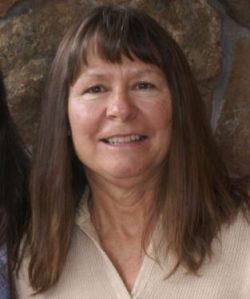
Diane has been involved with FeederWatch for ten years; however, she began bird-watching many years ago when she lived in California. Diane’s sister Sharon initially sparked her interest in birding. When Sharon moved to Washington, birding became a way to bridge the physical distance. Diane remarks, “It is now one of our ways of staying connected to one another even though we have both since moved and live even farther apart.”
FeederWatching
Diane now resides in Mancos, Colorado, which is located in the southwest corner of the state in a habitat referred to as the Piñyon-Juniper woodland or, as she describes it, “Lots of old, gnarly trees in an arid climate.” This unique high desert ecosystem has an abundance of birds and Diane attracts them in droves with a wide variety of feeders, foods, and water features. Diane suggests that adding water resources to count sites is a great way to attract non-feeder birds and increase the diversity of FeederWatch counts. Cooper’s Hawks, bluebirds, Western Tanagers, and Clark’s Nutcrackers are all frequent visitors to her birdbaths.
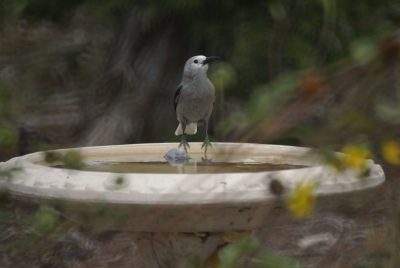
Her feeder birds include juncos, Mountain Chickadees, Pine Siskins, Bewick’s Wrens, Evening Grosbeaks, Black-billed Magpies, Western and Mountain bluebirds, Red Crossbills, three different jay species, and finches of all sorts—the list goes on and on! However, her favorite species is the White-breasted Nuthatch. She adores the “many noises they make and the fact that they seem to be oblivious to being nearby people.”
Community Involvement
In addition to backyard birding for Project FeederWatch, Diane serves as the chairwoman for the Ute Mountain Mesa Verde Birding Festival. Although Diane is modest in describing her role, this is no small feat! The festival requires eight months of planning and draws attendees from across the country and even abroad. She is also in involved in leading a monthly bird outing in her county and belongs to a birding club in a neighboring county.

Diane has recently expanded her birding activities to include another Cornell Lab citizen-science project, NestWatch, which studies the reproductive success of nesting birds. She installed six nest boxes and monitored the species, number of eggs, hatchlings, and fledglings and reported her observations to NestWatch. Diane remarked that she loves FeederWatch and “looks forward to it every fall. I was happy to find the NestWatch program, so I could stay involved for more months out of the year.”
Dorothy Schroeder
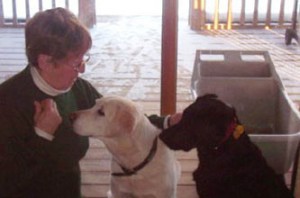
As the 18th FeederWatch season approached last fall, staffers at the Lab of Ornithology realized that a major milestone was rapidly approaching–the one millionth FeederWatch checklist would be submitted during the 2004-2005 season! We slowly watched the numbers of checklists climb towards 1,000,000 when, on January 10, 2005, Dorothy Schroeder of Mooers, New York, submitted the magic checklist.
Dorothy describes herself as someone who has always been interested in wildlife, but she does not consider herself a true birder. She has been feeding birds at her current residence for more than 15 years, but just recently joined Project FeederWatch.
Dorothy and her husband, John, lived in Westchester County in New York until they decided to “retire north.” That is when they moved to their current home in northern New York state near the Canadian border. Dorothy is a retired nurse whose last job was teaching nursing at Westchester Community College. She now trains her two Labrador retrievers for pet therapy and obedience, agility, and tracking competitions.
FeederWatching
Dorothy watches her feeders through her kitchen window while eating, doing dishes, or just passing by. She sees a consistent mix of feeder birds including chickadees, nuthatches, and woodpeckers. She especially enjoys a group of turkeys that occasionally visits.
Since starting FeederWatch, Dorothy has noticed more about the birds at her feeders. For example, one week she noticed that her group of little brown birds had changed from American Tree Sparrows to Common Redpolls, a change she may not have noticed if she were not FeederWatching.
Dorothy’s 2004-2005 counts
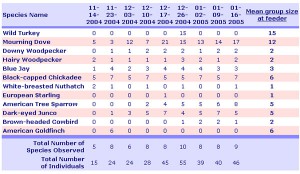
As can be seen by a summary of her FeederWatch counts through mid-January (right), Dorothy observes a typical mix of feeder birds for her area. FeederWatch relies upon participants who consistently report these common feeder species.
Dorothy’s feeders
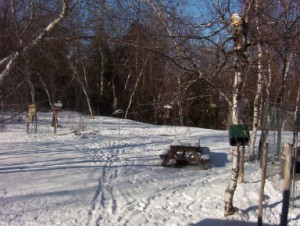
Dorothy maintains two hanging feeders, one filled with sunflower seeds and the other with a seed mix. A platform feeder is covered with cracked corn for the squirrels, jays, and doves. She provides seed at a weight sensitive “squirrel-proof” feeder, which one of her squirrels has figured out how to use by only putting one foot on the lever. Dorothy also provides suet for the woodpeckers, nuthatches, and chickadees. A brook runs behind the feeders that is surrounded by a mix of trees, which provides cover for the birds.
Celebrating 1,000,000!
For helping FeederWatch reach the one-millionth checklist milestone, Dorothy won a prize package that included a pair of Swift binoculars donated by Wild Bird Centers of America, a bird feeder donated by Wild Birds Unlimited, a lifetime of free participation in Project FeederWatch, the Birds at Your Feeder book (based on FeederWatch data), and a free Lab of Ornithology membership. Congratulations, Dorothy, and thank you for submitting checklist 1,000,000!
Thank you to all of the FeederWatchers who helped us reach this milestone, and continue to help us climb towards checklist 2,000,000.
Errol Taskin
Watching and photographing birds literally brought life to Errol Taskin after several years struggling to cope with permanent and painful disability. In 1998, Errol collapsed in his home, paralyzed, when a disk in his spine unexpectedly ruptured. He endured lengthy hospitalizations and unsuccessful surgeries. Eventually he regained the ability to walk with a cane but will always have pain.
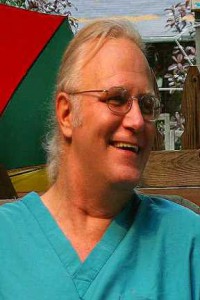
Prior to his disability, Errol was a private computer consultant specializing in financial system design. He loved finding solutions to problems that others could not solve, especially when he was told that he would never be able to figure them out.
Faced with the reality of no longer being able to work at the job he loved, he lost hope and gained weight. In 2004, he decided to spend his summer in the hot Louisiana sun to try to sweat off as much weight as he could. That’s when he discovered birds and photography. He wrote, “Sitting out there sweating, I began to notice all of these birds I had never seen before.” He could not see them long enough to look them up in a field guide, so he grabbed a cheap camera and began photographing them so that he could identify the birds from the photos. He went on to say, “One thing led to another and six cameras later I am still trying to get better shots…. And I lost 50 pounds in the process!”
Errol is amazed that he lived in his house, in a heavily wooded suburban neighborhood, for 18 years and never saw or noticed all the birds that visit his yard. He wrote, “The birds have really inspired me in many ways. It was a path I was meant to walk. I have learned much from them.”
FeederWatching
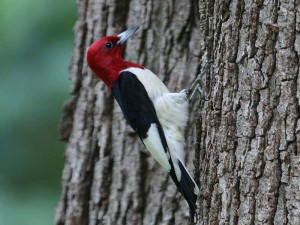
Errol watches his feeders two to five hours a day. He wrote, “Since I could not get to the birds, I had to get them closer to me. I have moved a group of feeders closer and closer to where I sit, and some of the birds come within a few feet of me now and have learned I mean them no harm.”
When asked about feeders, Errol said, “I cannot think of anything I do not offer.” Errol provides water, suet, sunflower seed, mixed seed, meal worms, orange wedges, jam, bread with mixed corn and peanuts, and nyjer seed. He usually also keeps at least one nectar feeder up, but in the summer he has as many as 15 spread across his ¾ acre backyard.
The birds
Errol’s favorite bird never comes to the feeder. He enjoys watching the Sharp-shinned Hawks that breed nearby. “Hawks are just magnificent birds that I never tire of watching.” Errol watches the young hawks learn to hunt–first on lizards, then mice and small snakes, and on up to larger prey. Errol enjoys watching all birds, though. He says that Carolina Wrens provide a lot of activity and humor, and Eastern Bluebirds are also a favorite. His most common feeder bird is the Northern Cardinal. His most unusual visitor is an Eastern Phoebe, which stays all winter: “He definitely marches to his own drummer–never eats out of the mealworm feeder but can catch them before they hit the ground when they crawl over the side.”
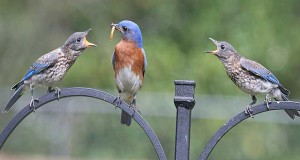
Errol has photographed over 50 species. He enjoys seeing the birds that only visit during migration but noted that they always seem to show up when he does not have his camera handy. The most surprising bird that Errol has seen was an egret (presumably visiting from a nearby lake) standing on the side of his bird bath.
FeederWatching tips
Errol recommends that in addition to food and water, FeederWatchers provide landscaping to attract birds. Berry bushes that he added attract beautiful Cedar Waxwings, and White-throated Sparrows are drawn to the brush piles he maintains near the feeders. He suggested that FeederWatchers consult information on landscaping for wildlife information that is usually provided on each state’s fish and wildlife department web site. Information can also be found at the National Wildlife Federation.
Giving back
Errol’s discovery of birds and photography has been a blessing to many. He has written extensively about his experiences, including an article about his beloved Sharp-shinned Hawks that originally appeared on his blog and was later published in the Spring 2007 issue of the Palo Alto Review . He is currently working with a high school to develop a program on birds and photography for gifted children. FeederWatch has used many of his photos on our web site and in print publications.
Fran Rutkovsky
Fran Rutkovsky first started watching birds as a child when she enjoyed seeing hummingbirds come to her mother’s flowers. She got her first pair of binoculars and bird guide in the mid-1970s when she and her husband, Paul, lived next door to a park in New Haven, Connecticut.
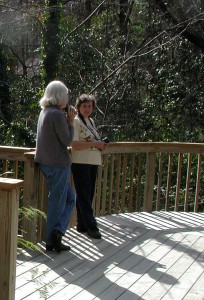
When she moved to Tallahassee in the early 1980s, she set up a feeder and bird bath. She wrote, “I kept my Peterson’s Guide and binoculars near the window and gradually got to know what birds were around.”
In 1995, Fran took a “Birds of North Florida” course that introduced her to birding sites on the Internet. Through an online chat group, she met a local birder and began connecting with her local birding community. She is now a member of her local Apalachee Audubon Society where last winter she chaired a committee that organized a “Wildlife-Friendly Yards Tour” fundraiser that sold tickets for birders to visit six bird friendly yards, including her own. She is a member of the Birdsong Nature Center in Grady County, Georgia, where she serves as a greeter at special events among other things, and she is a member of the Hummer/Bird Study Group in Alabama, which has sent bird bander Fred Bassett to band the rare hummingbirds that have visited her feeders. Fran also has counted birds for the Great Backyard Bird Count, the Audubon Christmas Bird Count, and the Audubon Birdathon.
FeederWatching

Fran first started FeederWatching in 1999 at her home in Tallahassee, Florida. She counts on every other Monday and Tuesday, checking her feeders periodically throughout her count days. She wrote that when she’s away for one of her scheduled counts, she “asks another birder or two to come over and count for at least a half hour on either or both days. Of course this is also when the rare winter visitors first show up!” She also invites any visitors to her home on FeederWatch Count Days to help her count.
The only time she remembers missing a count was after a car accident in Tennessee in December, 2004. She didn’t get back home until mid-January. She wrote, “Though I had to use a wheelchair and crutches for over two months, watching the birds kept me sane and entertained during my recovery. Local and visiting birders helped take care of my feeders and birdbaths.”
Homemade Blends

In addition to using some store bought suet, Fran makes her own suet based on the “Martha Sargent Super Suet” recipe:
1 Cup of Crunchy Peanut Butter
1 Cup of Lard (not shortening)
2 Cups of Quick Cook Oats
1 Cup of regular White Flour
2 Cups of Cornmeal
crushed eggshells (cleaned and dried)
Melt lard and peanut butter in the microwave or over low heat. Stir in remaining ingredients and pour (or spoon) into freezer containers that fit into your suet basket. Store in freezer or refrigerator until ready to use. Makes 6-8 cakes.
FeederWatch Count Site
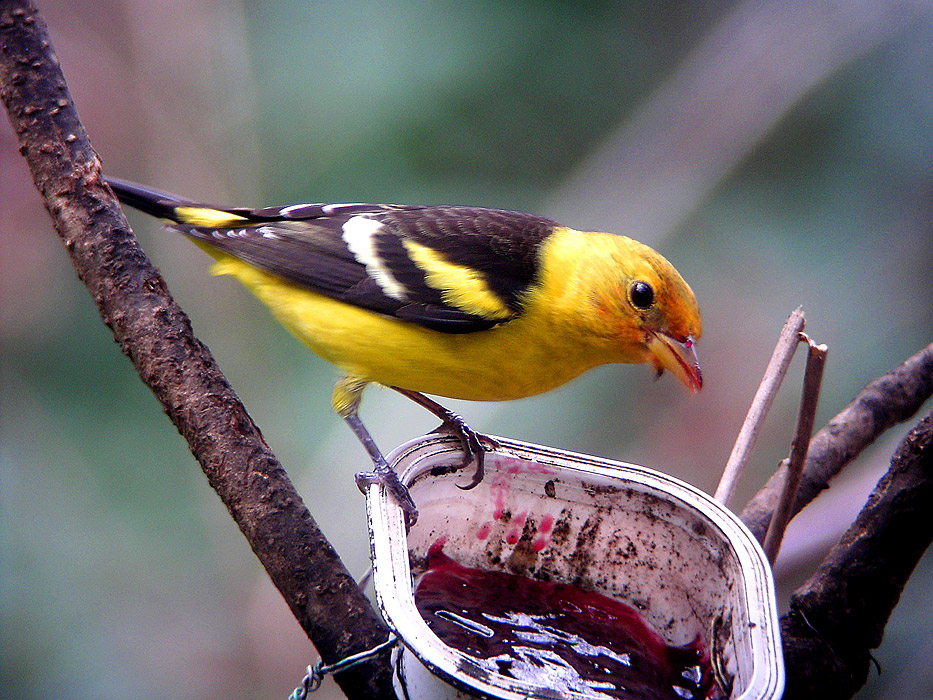
Fran lives on a suburban half acre with trees, shrubs, and flowers, some planted, some natural. She wrote, “The main attraction for birds is the sloping ravine in back with its tangled vines, trees, and stream at bottom.” Fran set up her backyard and part of the side yard with a variety of feeders and bird baths. She has two mist-sprayers that she usually runs for a couple of hours at mid-day. In winter she puts out grape jelly. She wrote, “Some years an oriole or tanager will, upon returning, go looking in the “jelly dish” even when I have not had anything in it since the previous spring!”
Feeder birds
Fran has been lucky to host a Western Tanager and a Bullock’s Oriole at her feeders for several winters, both rare for Florida in winter. Over the years, she has also had hummingbirds (Black-chinned, Allen’s, and Calliope) and a Summer Tanager unexpectedly visit her feeders in winter. But she enjoys all the birds that visit, from her common year-round resident Carolina Chickadees, Tufted Titmice, Northern Cardinals, Carolina Wrens, Bue Jays, and Red-bellied Woodpeckers to the uncommon feeder visitors like the Barred Owl that sat on top of a feeder pole and the Great Egret that sat on her deck rail.
Capitalizing on the birds
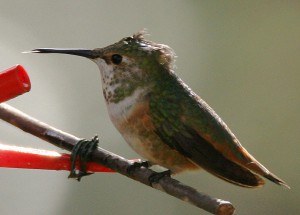
Because many people want to see the Western Tanager and Bullock’s Oriole, among other birds that visit Fran’s feeders in winter, Fran has opened her yard to lots of visitors. At the suggestion of one birder, she put up a small sign that says: “Donations are accepted and will be split between Birdsong Nature Center and Hummer/Bird Study Group”. She also puts out brochures for these organizations, Audubon, Project FeederWatch, Great Florida Birding Trail, and other bird-related organizations.
Herman A. Paulk
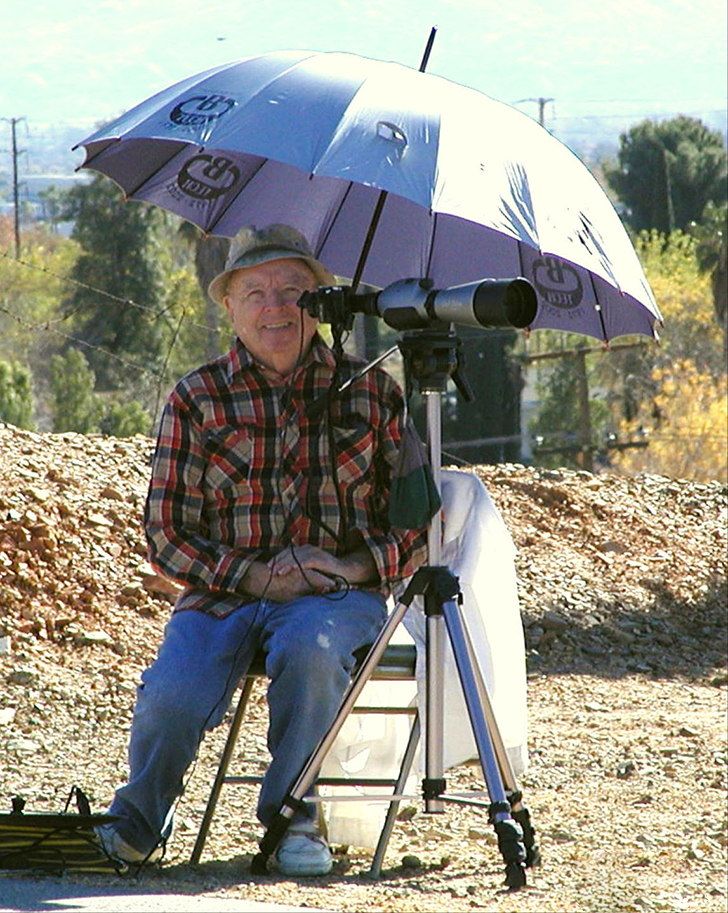
Atop a knoll outside of the San Bernardino Mountains, avid photographer and birder Herman Paulk has been FeederWatching since 1994 and tracking wildlife observations for over twenty-four years. Herman has recorded eighty-seven species that have visited his site, many of which he has captured in photographs. “We always have a camera available,” he says.
Herman and his wife live in the north end of San Bernardino, California, just below Devil’s Canyon. At an elevation of 1,700 feet, their home has a grand view of the San Bernardino Mountains beyond their backyard, making their site a natural pathway for a wide variety of birds and other wildlife passing through the area.
Wildlife Sanctuary
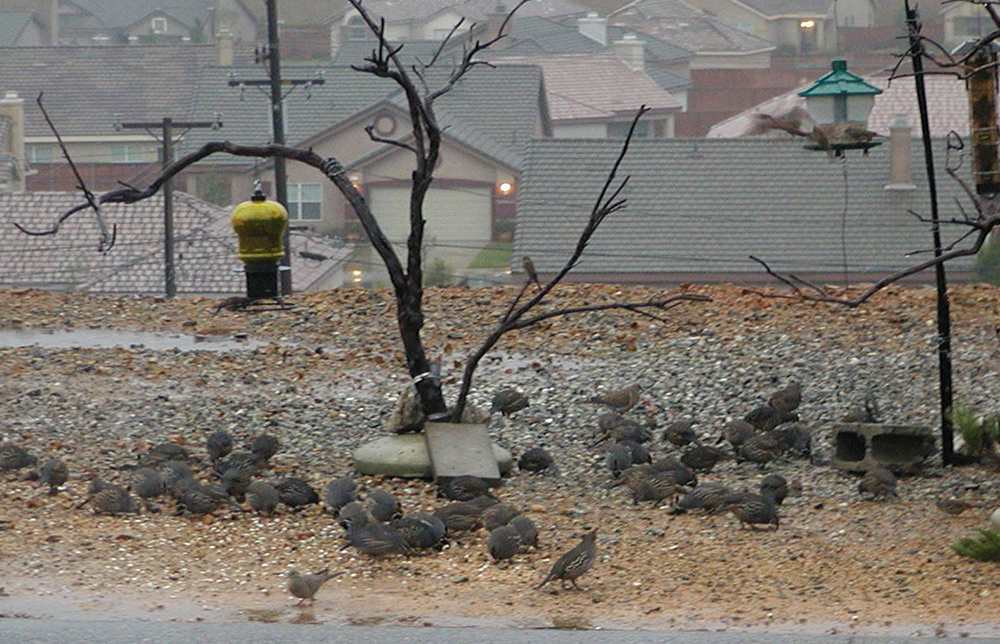
Years ago when Herman built his present home, he remembers, “one could not help but be interested in the wildlife.” At that time, he says, “it was a very remote area with abundant wildlife all around…[and] just a few homes scattered to the north, along with large abandoned grape vineyards. Now, most of the land has been developed…” High above the surrounding housing developments, Herman and his wife have turned their property into a wildlife sanctuary.
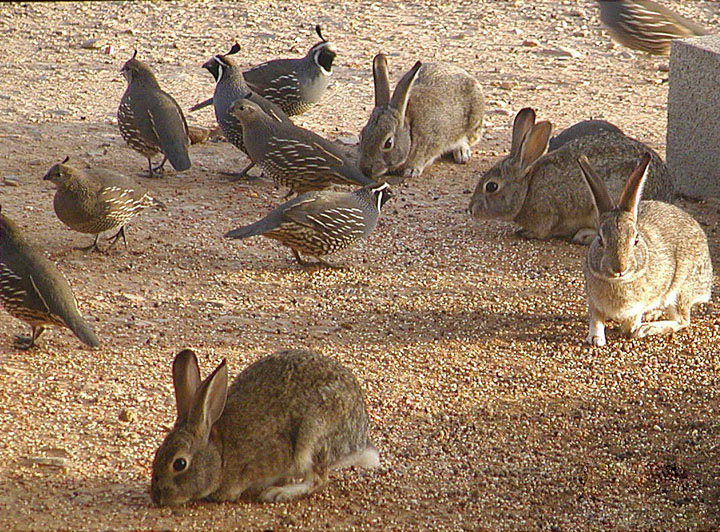
Large numbers of birds immediately flocked to their yard when they hung their first feeder several years ago. Since then, the Paulks have added fifteen bird feeders to their count site, each with multiple feeding stations. In addition, they provide nyjer seed and seed cakes for the finches and have two eight-station hummingbird feeders. During peak feeding times, Herman says it takes an average of fifteen plus pounds of bird seed daily to maintain all the feeders and ground feeding stations.

A bird bath offers a continuous supply of water for the birds and animals that come to drink or bathe at the Paulks’ count site.
Herman described the site as having very limited vegetation, except for a small Japanese Pine growing in the front yard. For cover, he provides a wood pile raised up on cement blocks that serves as a safety zone for the birds. He says, “The birds and rabbits use the area under the woodpile for refuge from hawks and from the heat of the day…There is no grass in our yard, just the natural earth which we keep free of any weed growth.”
On September 16, 1993, the National Wildlife Federation awarded the Paulks a Certificate of Achievement for the establishment and maintenance of a Backyard Wildlife Habitat.
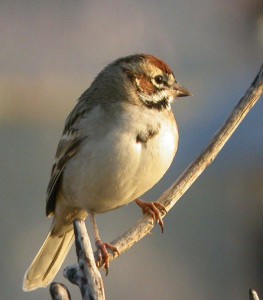
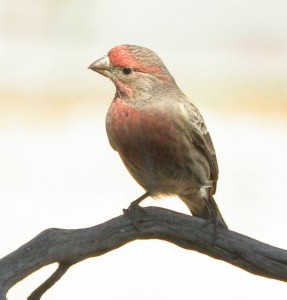
Visitors
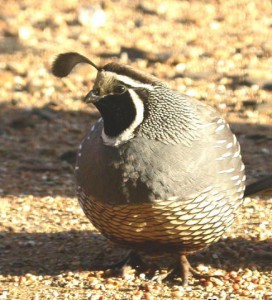
The Paulks eat their meals in front of the patio door to be entertained by visiting birds and rabbits. Most days, House Sparrows, House Finches, White-crowned Sparrows, Mourning Doves, Redwing Blackbirds, Brown-headed Cowbirds, California Towhees, Lesser Goldfinches, Lark Sparrows, and California Quail are regular visitors to their count site.
Occasionally, Greater Roadrunners, Western Scrub-Jays, California Thrashers, Northern Mockingbirds, and Eurasian Collared-Doves stop in to feed. The most unusual bird to visit was a Pin-tailed Whydah, which Herman says must have escaped from someone’s cage.

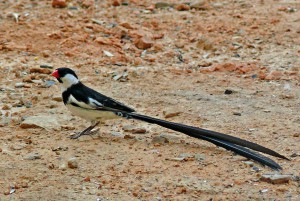
As homes and industrial buildings develop around their property, Herman says their site has become a “haven to the bird population as a source of food and water.” Unfortunately, he says, “predators also find it a great source for their next meal.”
Predators
Cooper’s and Sharp-shinned hawks frequently scout out Herman’s property for a good meal, but he says his feeder birds are constantly alert: “Almost anything can set the birds into panic flights. If it is a false alarm, they all return in just what seems a few moments. When it is a true attack, the birds stay away long after the threat is over. This pattern can go on for hours. Later in the day the threat is less, as the hawks have usually satisfied their needs.”
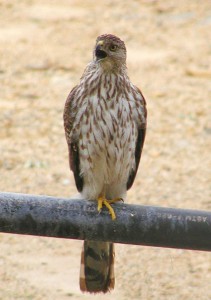
Birds take sanctuary in an area Herman created out of cement blocks, boards, and chain link fencing, designed specifically to offer shelter and safety for the wildlife in his yard.
He says, “With daily attacks by the hawks, it has caused other bird species to change their habits of visiting our feeder site…Now, because of the frequency of hawk attacks, quail come in much smaller numbers and stay for only a short time. They usually stay close to the sanctuaries and are ready to flee instantly.”
The California Thrashers, he says, are also wary of the frequent hawk attacks in his yard:
“When they visit, they first sit on the fence for a while checking out the yard thoroughly. If they do not like what they see, they leave without visiting the feeding stations. If [they] do come…they stay close to the sanctuaries and leave within a short time.”
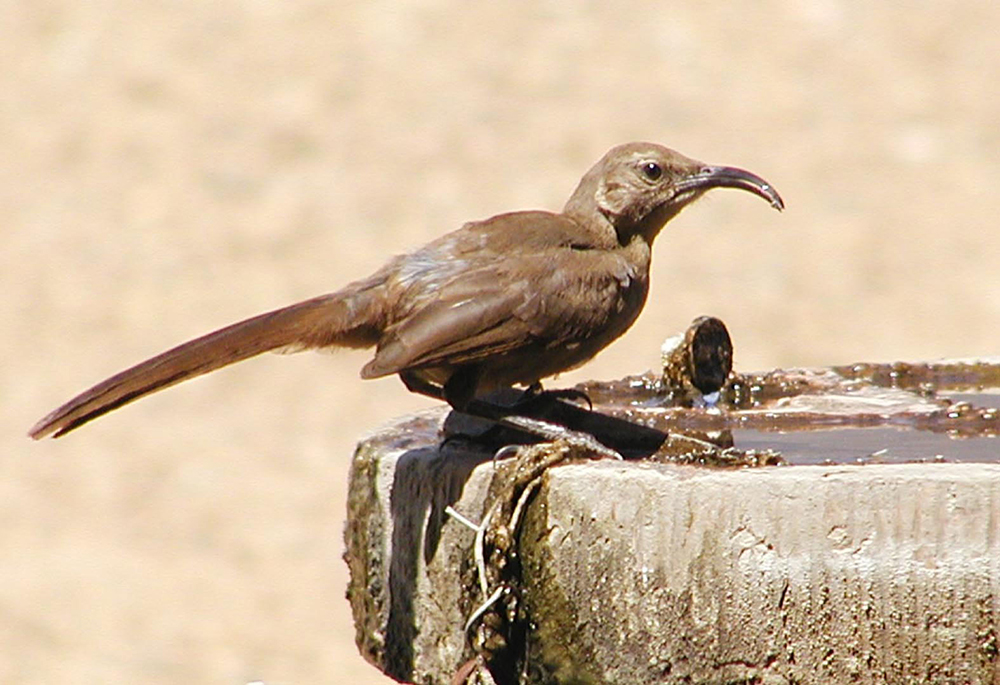
“We also have a Merlin that likes to hide out in the Japanese Pine in the front yard to attack birds,” he says. American Kestrel and Red-tailed Hawks have made appearances, often swooping in after young rabbits. Herman has also witnessed a Loggerhead Shrike claiming a small bird and chasing field mice through his yard. Greater Roadrunners, he tells us, usually have different techniques in their quest for prey: “Some will wait under the bush for the birds to come, other times they go right into the bush for the birds. They are comical, but very deadly.”
“The coyotes come around our site every once in a while. I see them mostly in the early morning hours. I do my exercises in the early morning looking out our glass window and that is when I usually see them.”
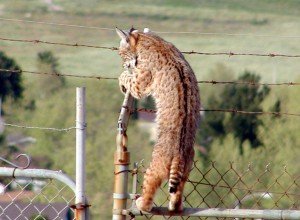

Favorite Bird
Of all the feeder birds, Herman’s favorite is the California Towhee, which he says has “more character than any other bird,” because they always seem to be happy and tend to shy away from the crowd of other birds. Towhees are “a very curious bird,” he says, “whenever I am doing any work in the yard, they are usually around to check out just what I am up to.”
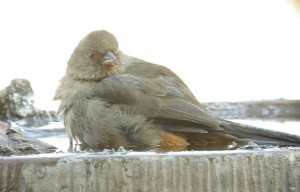
When a small snake crawled into one of their planters, Herman observed as “the towhee got up to where the snake was and watched it, tilting its head several times, until the snake disappeared into the planter…. These birds have a great personality, they are always very perky, hopping about with their tail snapping, and they like to sing.” Herman enjoys watching them do what he calls the “Towhee Shuffle” when they scratch for seeds, and he gets great entertainment seeing them chase their young through his wood pile.
FeederWatching for Photographs
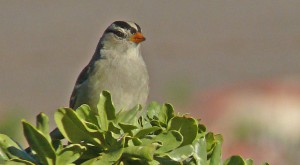
Herman begins his FeederWatch routine “very, very early in the morning,” and says, “In fact, it’s not yet light!” During these early hours, he observes White-crowned Sparrows making their early rounds to feed—a technique he says they have learned to avoid predator attacks in the daylight.
Watching from his dining room table through the glass sliding door to the backyard, Herman mounts his digital camera on a table top tripod and says he is “always ready to take pictures when the right opportunity comes along.” For five or six hours a day, he watches and waits with the camera for photo opportunities.
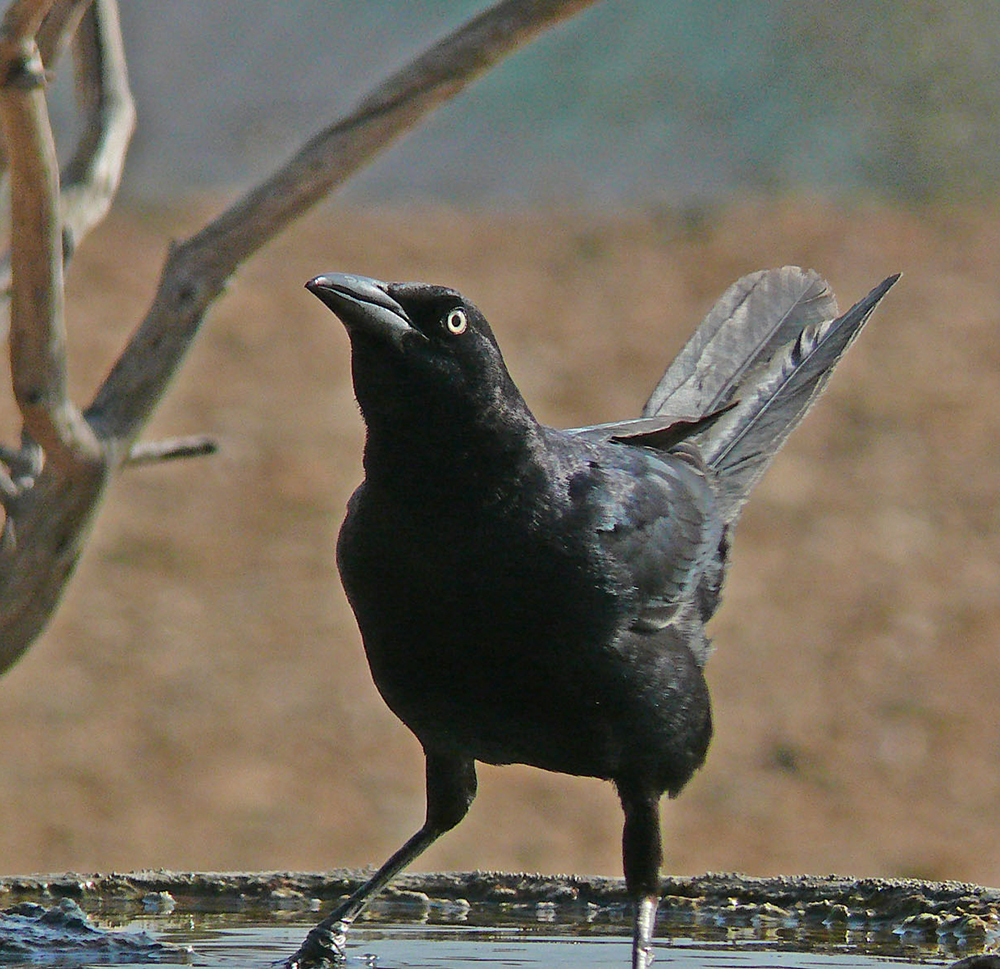
“The one thing FeederWatch does for me—it gives me an excuse to sit most of the day when I do my count and watch for good bird and animal pictures. Otherwise, I would feel like I’m wasting time, but this way, while I am waiting for good pictures, I’m also counting birds.”
Adaptation
In all of his years of FeederWatching, Herman says one thing is for certain, “change is constant.” Like the birds, Herman adapts to the changes that affect his area.

Since panic flights make it difficult for him to get an accurate bird count, when a large flock arrives, Herman takes a picture before they can fly off: “With a digital camera I can put this picture into the computer and make a print, then easily count the numbers of birds present and have a permanent record for that count day.”
In addition to Project FeederWatch, Herman has given talks on wildlife photography to school children and other organizations and exhibits some of his photographs on local bird forums.
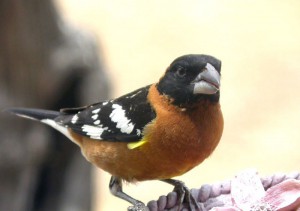
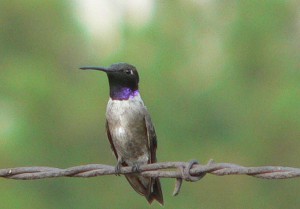
All photos in this feature were taken by Herman Paulk. Read more about Herman ’s report on the California fires of 2003 that swept through the San Bernardino area near his home.
Ida Sheppard
Ida Sheppard of Cassville, New York, joined Project FeederWatch 20 years ago. Ida’s interest in birding began when she discovered the simple pleasure of watching her backyard birds. She began Project FeederWatch at a time when flocks of Evening Grosbeaks were still prevalent across the region.
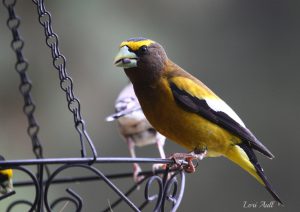
Like many of our long-time participants, Ida notes, “I have not seen any grosbeaks in years, and I miss them.” The decline in the Evening Grosbeak population has been documented with the help of long-term data from FeederWatch. Cornell Lab scientists are able to document the extent of declines and to map the changes in distribution of wintering populations. Read more about Evening Grosbeaks and see a map of changes in the birds abundance and distribution.
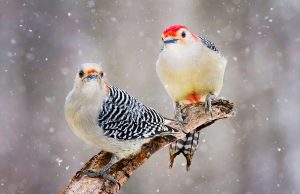
Ida provides her feathered friends with a variety of foods including black-oil sunflower seeds, suet, and millet. In the summer she puts out oranges for her summer visitors, which include Baltimore Orioles. Ida reports that in winter her feeders attract the species typically seen at feeders in the Northeast, including her most common visitor, the Dark-eyed Junco. Her favorite bird is the Northern Cardinal, and her most unusual bird is the Red-bellied Woodpecker—a species that has been expanding its range northward in recent years.
Janet Allen
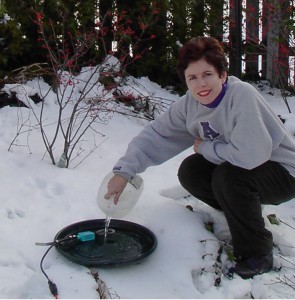
Janet Allen has been a FeederWatch participant for four years. She learned about the project while exploring National Wildlife Federation’s Backyard Wildlife Habitat program. Her yard in Syracuse, New York, was certified as a Backyard Wildlife Habitat in December 2000. She said that her interest in birds grew as her yard became more wildlife-friendly.
Janet’s interest in conservation has also grown with the improved habitat in her yard. She has reserved a space in the yard for a “solar clothes dryer,” she purchases 100% wind energy, she bought an electric/gas hybrid car, and she advocates for a responsible national energy policy.
Feeding area
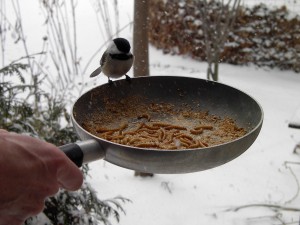
Janet has a wide variety of feeders, which she varies depending on season or need. When she has large numbers of goldfinches or other finches, she puts up extra finch feeders. She provides mealworms for the chickadees by placing them in an old frying pan that she holds out to them. She says that if she left the mealworms out unattended, House Sparrows would eat them.
She provides a hummingbird feeder only in early spring and late fall. The rest of the summer she relies on her native plants to attract the hummingbirds. That way, she says,”I don’t have to worry about cleaning feeders!”
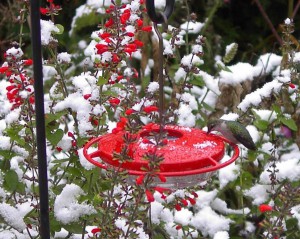
Janet monitors her feeders from her family room/home office. Her computer is next to a bay window overlooking her backyard. She enjoys her view, even when she really ought to be attending to what is on her computer!
Bird feeding tip
In addition to providing feeders, Janet recommends providing for other needs. She planted bushes with berries that last into winter and evergreen bushes that supply cover year-round. She provides clean nest boxes as well as a roost box, and she uses a heater in her birdbath to provide water all winter.
Jeff Guy

Jeff Guy has been FeederWatching since 2005. He lives in a rural mining town called Maysville, perched at 8,393′ in the central mountains of Colorado. Yearly precipitation averages 16.0″/year with 93″ of average snowfall. He sees many of the high elevation species that many FeederWatchers can only dream of seeing, such as Clark’s Nutcrackers, Pinyon Jays, Cassin’s Finches, and in amazing numbers, rosy-finches.
In addition to birds, the woods around his home harbor bears, as the family discovered soon after moving in. While Jeff and his wife were away, a family member staying in the house was awakened in the night by a strange sound. Jeff wrote, “Soon he was greeted by a bear snout smudging the kitchen door’s glass…. Seems the bear took a liking to the hummingbird feeders. The bear would stand on his hind legs and lick syrup from the feeders…. I quickly learned to bring in the feeders at night. A fed bear is a dead bear.”
Jeff began birding on his family’s ranch
Jeff’s grandmother gave Jeff’s older brother the Golden Guide’s Birds of North America when Jeff was in junior high school. Soon both were hooked on birding. Jeff grew up on a 3,000-acre ranch in Colorado. Part of the ranch was a Ponderosa Pine forest. Jeff wrote, “Within its shady reaches, I discovered a tapestry of bird mysteries. For example, it took me a long time to discover that the gentle call of the mourning dove was not an owl! I remember identifying my first bird in that forest, a Mountain Chickadee.”
FeederWatching
During the FeederWatch season, Jeff keeps an eye on his feeders through French doors in his living room. He wrote, “Just a peek might bring a surprise…. Jays, sparrows, finches, hummingbirds, grosbeaks, Pine Siskins, pigeons, and chickadees are frequent diners at my mountain cafe.”
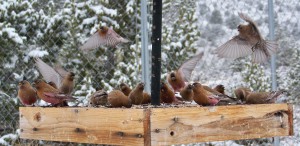
Jeff has a hopper feeder filled with white millet and sunflower seeds, tube feeders brimming with sunflower seeds, a nyjer-seed feeder, and a platform feeder loaded with whole corn, sunflowers seeds, and white millet. In the winter, the most common bird at Jeff’s feeders is the junco, which can number more than 100, especially during winter storms. Cassin’s Finch numbers can also be as high but not every year.
Lots of rosy-finches!
By far the biggest flocks of birds at Jeff’s feeders are the rosy-finches. Primarily high elevation birds, few people are lucky enough to host these beautiful little birds at their feeders.
There are three rosy-finch species: Brown-capped, Gray-crowned, and Black. Like many other finches, they tend to gather in large flocks, especially in winter. Jeff has estimated seeing as many as 500 rosy-finches at his feeders. The majority of the rosy-finches at Jeff’s feeders are Brown-capped Rosy-Finches with a few Gray-crowned and Black rosy-finches mixed in.
Tips for FeederWatchers
Jeff says that the most beneficial thing to provide for birds is a safe yard. He has a moveable chain link dog pen that he uses to keep cats away from the feeders. The birds love to perch on the fence. The pen has the added benefit of protecting the feeders from deer.
Joyanne Hamilton
At the Innoko River Junior and Senior High School in the small village of Shageluk, Alaska, secondary teacher Joyanne Hamilton teaches her students the importance of understanding seasonal and environmental changes and how they affect local wildlife.
An Extraordinary Visit
Joyanne saw firsthand how environmental shifts can bring the extraordinary to her own backyard when a Brambling ventured 200 miles inland to her village on the Innoko River. This type of Eurasian finch typically winters in southern Europe, North Africa, northern Pakistan, northern India, China, and Japan, though occasionally a few will wander into Alaska along the western Aleutian Islands. Four sightings have been reported on the mainland in the coastal villages of Anchorage, Homer, on Kodiak Island, and in Petersburg in the Southeast, but this was a first for Shageluk.
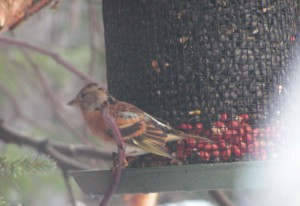
In September 2007, the Brambling made its first appearance at Joyanne’s feeders and stayed for about a month before moving on. Biologist Susan Sharbaugh of the Alaska Bird Observatory in Fairbanks first confirmed the Brambling’s identification based on photos Joyanne sent. Joyanne wrote, “Unfortunately, other than the photos, my students didn’t get a chance to actually see it. By the time we made arrangements for them to come to my house, the bird had stopped coming. I was devastated!” Though her students did not get to see the Brambling firsthand, the unusual visitor offered a unique element to their classroom discussion on climate change.
Students Study Environmental Shifts
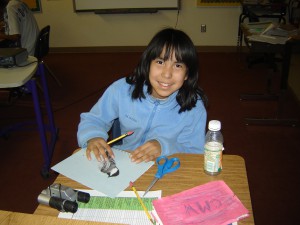
For over a decade, Joyanne has participated in Citizen Science projects like Project FeederWatch with her class, help her students learn about wildlife migration and local habitat. FeederWatching from their classroom windows, her students study the “fly-ways” and feeding patterns of the birds that visit. By the time the Brambling arrived in her backyard, Joyanne says her students were “pretty savvy already about the possible route the bird took” to Shageluk. Having studied the weather systems that roll up the Aleutians, her students concluded the Brambling was probably “just blown off course in one of the storms.”

In addition to the excitement in her classroom, the Brambling’s visit spotlighted Shageluk, inspiring the Fairbanks Daily-News Miner to feature a story on the tiny village. Home to less than 130 Native Alaskans, Shageluk is a traditional Athabaskan community that depends on migratory birds and fish for subsistence. “People’s ties with the land and animals are still very strong,” Joyanne explained. For this reason, she believes understanding environmental and seasonal changes and how they affect those animals is crucial to the survival of Native Alaskan cultures.
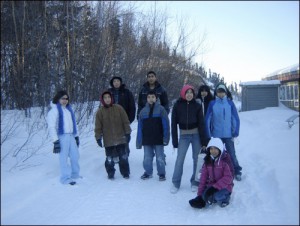
As a teacher, Joyanne has provided opportunities for her students to make educated observations and conclusions on their own, instilling in them a curiosity and desire for environmental awareness. “Programs like Project FeederWatch enable local observations to be made and validated by western-‘raised’ scientists,” she wrote, “I really love that.”
FeederWatching Tips

Joyanne suggests putting feeders near cover: “Often the birds will chow down at the feeders, but if something threatens their dining, they like to have those tall trees right there to fly to.” Hanging her feeders in and around trees, she keeps them stocked with black-oil sunflower seeds and sometimes combines millet and wild bird seed to see what the seeds will attract. In addition, she provides suet and spreads peanut butter on a nearby tree branch. When asked what attracted the Brambling to her feeders, she suspected it was the sunflower seeds, though she says, “The Alaska Bird Observatory people told me it was probably after the millet.”
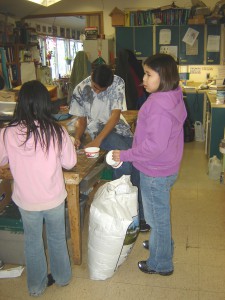
Though Joyanne was heartbroken to see the Brambling go after spending a month at her feeders, she is still enjoying the discussion it stirred up in her classroom and the excitement it brought to Shageluk.
Karen Barr
In early November, 2003, Karen Barr wrote to tell us that she would not be able to participate that season but hoped to be back at her Count Site the next season. Karen was one of several FeederWatch participants victimized by fires in California in October 2002. Karen’s home in El Cajon, California, burned down.
Karen wrote, “It broke my heart (but yet gave me hope) to see my covey of quail running in confusion on a blackened hillside looking for shelter when I returned to find the ruins of my home. I dumped the rest of my unburnt seed and filled the water bowls with water I had in the car.”
Feeding area
Karen had only participated in FeederWatch for one season before the fire came, yet she was already a devoted participant. She has been feeding birds for over five years. She described the feeder area she created that was lost in the fire: “I set up a pretty elaborate wildlife feeding station with many different kinds of feeders and watering stations. My friends called it Disneyland for birds. I had hanging tube feeders, trays, thistle socks, ‘house’ types, suet feeders, and hummingbird feeders. Most were hanging from poles, or attached to tall posts. I provided a good quality seed mix, black oil sunflower seeds, thistle seed, and suet blocks.”
Favorite bird
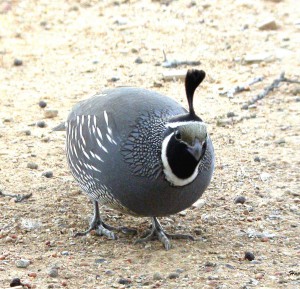
“My favorite birds at the feeders were the quail,” Karen wrote. “It took about two years before they stopped scattering when they perceived movement in the house. Last year was the first year they actually brought young to the feeder area. I love the way they stay in a group, follow in a line, watch out for each other, cluck and chuckle as they feed, and care for their young.”
Karen went on to say that her most common feeder birds were sparrows, finches, jays, doves, and towhees. Her most unusual visiters were a Lazuli Bunting and a Scott’s Oriole.
Bird feeding tip
Karen recommends keeping as much native vegetation as possible. Birds are naturally attracted to native plants. Also, she found that providing water attracted birds that are not seed eaters.
Local feeding perils
Karen once saw a bobcat stalking the birds at her feeder. Much to her dismay, she suspects it was snacking on baby quail. Also, she occasionally found a diamondback rattlesnake curled around the base of a feeder waiting for resident rodents. She learned to be really observant after almost stepping on one while filling the feeders.
Karen McCarthy
From the beginning
Karen remembers always having a bird feeder in the backyard growing up. She wrote, “My grandfather got me interested in birds. He would make up stories about the birds in his yard and mail them to me with little sketches.” As a child Karen painted models of birds.
Karen joined Project FeederWatch during its inaugural year in the United States. As if her long-time support of Project FeederWatch were not enough of a contribution, with 18 years of data collection and participant fees, Karen, an area manager for Consumers Energy, has secured several contributions for Project FeederWatch from her employer. She wrote, “I’m fortunate to work for Consumers Energy, whose Foundation recognizes employee volunteers by contributing to qualifying organizations on their behalf.” The Consumers Energy Foundation donated $100 to FeederWatch on Karen’s behalf in 2005.
Karen has enjoyed her many years of FeederWatching and reports that counting the birds “makes dishwashing go more quickly!” She also enjoys FeederWatching because “It adds another dimension to the change of seasons and weather and helps scientific research at the same time!”
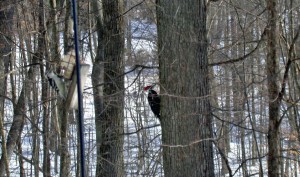
Karen has passed the bird watching bug on to the next generation. She wrote, “Our son has been counting and identifying birds since pre-school.” He is now a teenager and enjoys FeederWatching with Karen and her husband.
Habitat
Karen lives in a rural/suburban neighborhood in Ada, Michigan, (east of Grand Rapids) with 1.5 acre lots that are mostly wooded. She says that the snow starts in late fall but usually waits until after Thanksgiving to start accumulating. She wrote, “Sometimes we get a ‘January thaw’ where the snow melts, but otherwise we have several inches on the ground until March, with occasional ice added.”
Feeding Tips
Karen encourages her fellow FeederWatch participants to take advantage of the FeederWatch web site to help with bird identification and to learn new as well as tested feeding techniques.
Kathy Marie Gaider
Kathy Marie Gaider participates in Project FeederWatch and takes fabulous wildlife photos from her home in Dauphin, Manitoba. She has been FeederWatching since 1998, shortly after she moved to her current home.
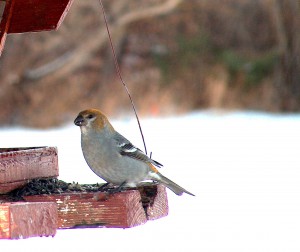
Like many FeederWatchers, Kathy’s first interest in birds came from feeding birds in her yard. When she bought her home, there were empty feeders in the yard. She filled them, and soon an unknown bird appeared. She searched through “fifty pages” in her field guide before finally discovering that she had a Pine Grosbeak (pictured at right).
Soon after, she heard about the Christmas Bird Count and Project FeederWatch, and began watching and counting birds.
Kathy counts her birds for FeederWatch while sitting at the large bay window in her living room. She also watches birds from her back windows and from her back deck, where she enjoys photographing the birds. One of her Pine Grosbeak photos was featured on the 2003-2004 Bird Watching Days calendar. She says she watches birds, “every weekend all year, eight hours a day. It has become an obsession!”
Feeders, feed, and tips
The Gaiders have three feeders, two small and one large. Kathy found that the birds visiting her feeders do not like the mixes, so she feeds only black-oil sunflower seeds. Kathy recommends feeding birds year-round, forgetting the expensive seeds and mixes, and keeping feeders clean.
Habitat
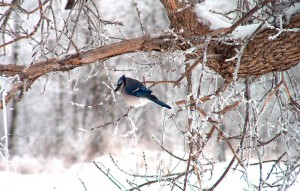
Living in a rural area, 500 feet from Riding Mountain National Park, birds, like the Blue Jay pictured at right, naturally find Kathy’s yard. The Gaiders have planted maple trees, a 6000 square foot garden, and are now developing an orchard with apple and cherry trees.
Weather
During the FeederWatch season, the average daytime temperature in Dauphin, is -15° to -25° C, according to Kathy. Sometimes it gets down to -40° C at night. The snow cover is inconsistent, from about two feet some years to very little in drought years.
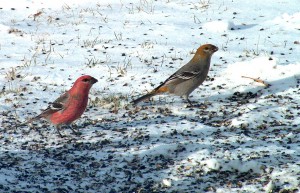
Kathy has been conducting an informal study of the weather’s affects on the birds in her yard. For example, she reports, “When the Pine Grosbeaks have arrived early, we’ve had above normal snowfall.” It’s too soon yet for her to know if Pine Grosbeaks can forecast snowfall over the longterm, but if they can, Kathy will probably be the one to find out.
Evening Grosbeaks

Kathy has been keeping track of her Evening Grosbeak counts ever since she started FeederWatching. She created the graph below, which shows the variation in the number of Evening Grosbeaks in her yard within and across seasons.
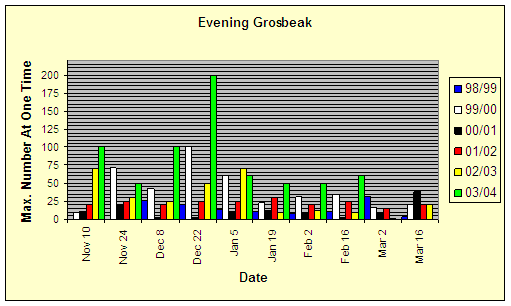
Kathy Gaider’s 2003-2004 counts
As can be seen from Kathy’s online summary chart for most of the 2003-2004 FeederWatch season (below), Kathy attracts a nice variety of birds to her feeders. For everyone who has been wondering where all the Evening Grosbeaks and Pine Grosbeaks have gone, apparently they have all gone to Kathy’s yard!
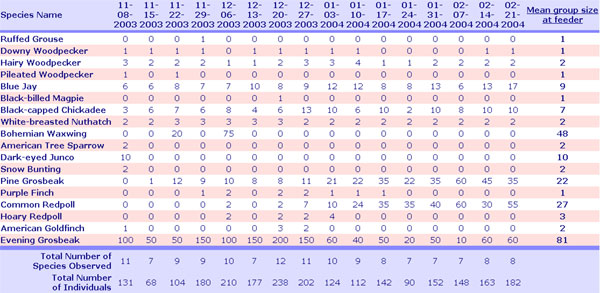
Kim Vespa
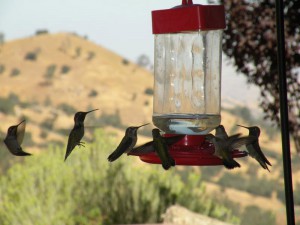
In the heart of the Tehachapi Mountains in rural California between the Mojave Desert and San Joaquin Valley, FeederWatcher Kim Vespa hosts a haven for hummingbirds that visit her feeders all year long. While many FeederWatchers anxiously await spring migration for the return of the hummingbirds, Kim Vespa is one of those fortunate FeederWatchers who has Anna’s Hummingbirds visiting her feeders all year long.
In winter, Kim goes through about 8 cups of nectar every 5 to 7 days. Then in the warmer months of spring and summer when the Rufous, Allen’s, Black-chinned, and occasionally, Calliope and Costa’s Hummingbirds return, she fills 7 hummingbird feeders, going through 24 cups of nectar per day in the peak season. “Maybe they could eat more,” she said, “but that’s all I make.”
Kim sent us this video of the busy hummingbird activity at her feeders in summer. She said it “helps to explain why we burn through 24 cups of hummingbird food a day.” Kim described the video as capturing “a typical August morning” outside of her bedroom window, “the noise at the feeders works as the alarm clock.”
As many FeederWatchers have probably observed, hummingbirds tend to be territorial when it comes to their feeding grounds, but Kim captured an intriguing situation where feeding aggression was calmed by the crowd. “The hummingbirds are aggressive toward each other,” she told us, “but when they are so plentiful, they seem to agree to have a little peace and tend to share the feeders.”
Kim has counted up to 36 hummingbirds at once in the fir tree beside the feeder. “They often buzz my head and do often buzz our dogs while they are laying down sleeping. They can get within inches of my face, sometimes just to say hello.”
Kim’s count site
At 4,600 feet elevation, Kim’s count site is situated behind her home where the ground is elevated on a slope and covered with native rabbit brush, oak trees, and some horse pasture. There she feeds birds throughout the year, hanging feeders close together in winter in one or two trees and on garden hooks and spreading them out in summer, “so there is less fighting, between the hummingbirds mostly,”
she said.
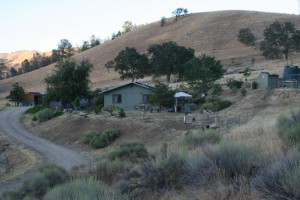
Kim has planted many trees, including some flowering and fruit trees. Flower gardens and a few tomato plants surround the perimeter of her house, along with flowering butterfly bushes, canna lilies, and other drought-tolerant plants that attract hummingbirds, butterflies, and goldfinches.
In winter, Kim provides suet for woodpeckers and nuthatches. She said that she used to provide black-oil sunflower seeds but noticed no change in the number of birds since there is plenty of natural vegetation in the yard that attracts a variety of species.
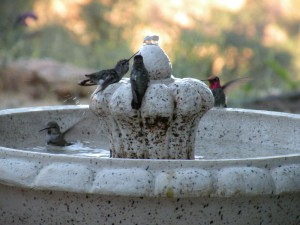
According to Kim, the water features draw most of the different species to her yard. “I have two fountain bird baths and two standard bird baths, and we made a tiny pond under the tree in the front garden,” she told us. A variety of birds frequent the watering holes year-round and many take drinks straight from Kim’s irrigation hose when it comes on in the morning, such as quail and California Towhees. The bird baths also attract the hummingbirds, which usually visit them first thing in the morning. “I have seen up to 7 hummingbirds trying to use it at the same time. It wasn’t running yet that early, but they kind of make a little splash across the surface of the water. When it is pumping, they like to sit on the top tier and submerse their faces or bodies on the water pumping out.”
More about Kim
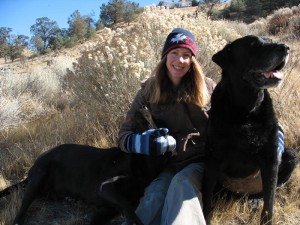
Raised in Southwestern Ontario, Canada, near the shores of Lake Erie, Kim said she has been interested in wildlife and the environment since a very young age. She started birding at Point Pelee National Park, and she said, “I got hooked as soon as I bought The Sibley Guide to Birds and was able to start identifying birds on my own.”
In addition to Project FeederWatch, Kim belongs to the Sierra Club, NRDC, Defenders of Wildlife, as well as other local environmental groups. In her free time, she enjoys spending time with her husband and their dogs, Jake and Fargo, in their backyard watching all of the different birds and wild animals that visit.
Mary Crow
Bird-watching is often passed down from generation to generation. That was certainly true for Mary Crow of Sisters, Oregon. Mary’s interest in birds was piqued at a young age. She recalled a family tradition, “Each fall was a celebration of the return of the robins to the Mountain Ash tree in our backyard. We’d laugh and enjoy their drunken behavior as they consumed the fermenting berries.”
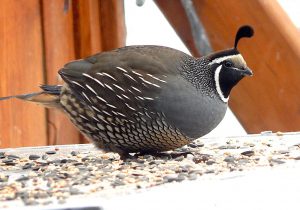
FeederWatching
At the urging of a friend and FeederWatch participant, Mary joined the FeederWatch program in 2006 as a way to avoid cabin fever and get through the long Oregon winters. Her count site consists of a large platform feeder on a six foot pole (to prevent the mule deer from emptying the feeders), several suet cakes, cracked corn for ground-feeding birds, and thistle feeders.
With that simple setup, Mary is able to attract a diversity of species including: Mountain Chickadees, Pygmy Nuthatches, California Quail (imagine 50 quails crammed on a platform!), Eurasian Collared-Doves, Steller’s Jays, California Scrub-Jays, Cedar Waxwings, juncos, American Goldfinches, House Finches, grosbeaks, and woodpeckers. Her favorite species is the White-headed Woodpecker, which also nests in the area.
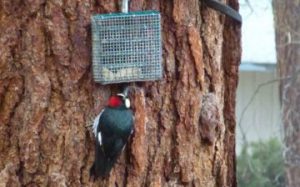
Community Involvement
In addition to her backyard birding for FeederWatch, Mary is active in the local community. She lead hikes for the Deschutes Land Trust and often enriches the experience by incorporating her birding know-how. Mary’s sharp eyes were the first to spot an Acorn Woodpecker in her area. The woodpecker’s normal range is in Oregon’s Willamette Valley, not on the eastern side of the Cascade Mountains where she photographed it at her count site during the 2014-2015 FeederWatch season.
Birding Tips
When asked about tips for fellow birders, Mary had some great ideas including learning to bird by ear. “Learning the bird songs opened up and expanded my understanding of the world around me. Now, when I’m out hiking, kayaking, skiing, biking, or gardening and I hear a bird, I usually know which bird has joined me on my adventures, even if I can’t see it. It’s like having a friend stopping by to say ‘Hi’ for a few minutes.”
To help expand her bird knowledge, Mary also found the Cornell Lab’s Home Study Course a great resource and noted, “It was an amazing experience to completely immerse myself in the birding world for several months. Now I have a wealth of reference material, and the answers to many questions about bird behavior.” The Home Study Course has been updated and is now available through the Lab’s Bird Academy as the university-level, self-paced course, Ornithology: Comprehensive Bird Biology.
Michael Wiegand
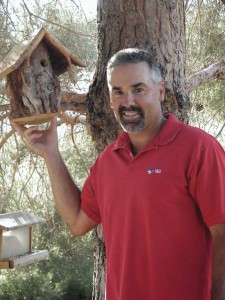
Michael Wiegand became hooked on birds at the age of thirty while watching Western Scrub-Jays fly through the yard of his first home in an older, semi-rural part of San Diego, California. “I thought ah-hah! I bet if I put some peanuts out in an old pie tin nailed up on a post in the garden, they’ll stop and visit me,” he wrote. At that point, he rounded up a stake, some peanuts, and a pie tin, and says, “the rest is history!”
Today, Michael lives in the foothills, twenty-five miles northwest of Boise in the old mining town of Pearl, Idaho. “We are very fortunate to not only live in a rural area with very few homes but also along a migratory corridor that funnels birds to our yard…especially in winter!” he wrote.

Over the years, he has added a variety of native plantings to his yard, including hawthorn, serviceberry, chokecherry, currant, and juniper. Michael describes the four-acre lot that he inherited as a “mostly coniferous setting,” which includes “a shrub-steppe habitat with a ribbon of riparian habitat” coursing through it. The combination of mature Austrian pine trees, flowering fruit trees, and native plants, he knows firsthand, “makes for a true birding magnet.” He also maintains two large brush piles, providing additional cover for the birds, as well as several bird baths.
Early Birding
“Birding is like a treasure hunt for me,” Michael told us. “The first thing I do every morning is put on my glasses and grab my binoculars and head for the bedroom window before I even get dressed.” One day, he says, he will write a book about his routine and call it “Confessions of the Naked Birder!” With an array of feeders hanging from an old ash tree outside his bedroom window, Michael spends hours every winter weekend morning watching and keeping a tally. The feeders are a “magnet to the over-wintering birds,” he says, bringing “hundreds of birds…with several vagrants mixed in each season.”
Bird Magnet
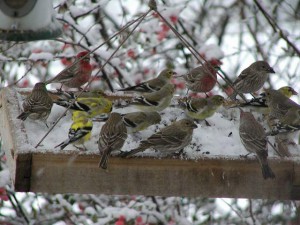
A variety of nearly forty feeders is scattered throughout the Count Site, which Michael says is the key to attracting multiple species. He provides hopper and tube feeders, a hanging tray, suet cages, nyjer socks, and peanut feeders, among other types. In most of his hopper, tray, and tube feeders, he offers mixed seed with millet, cracked corn, black-oil sunflower seed, some peanuts, and mixed nuts. In addition, he provides nyjer seed in both sock and tube feeders. Michael also has sunflower seed feeders and fills his suet feeders with both commercial and homemade suet.
For the ground-feeding birds such as sparrows and juncos, he sprinkles millet and cracked corn under shrubs and trees. With about two dozen species visiting his feeders each winter weekend, he says, the birds consume an average of 750 pounds of bird seed per month, though some months call for over a thousand pounds.
Feeding Frenzy
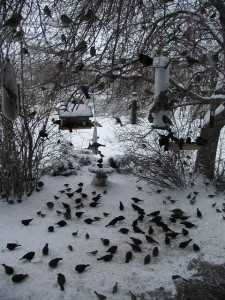
According to Michael, approximately one thousand birds visit his feeders each weekend, with some counts surpassing a thousand each day. The highest concentrations occur with Red-winged Blackbirds, California Quail, American Goldfinches, Pine Siskins, Mourning Doves, White-crowned Sparrows, Dark-eyed Juncos and House Finches, all of which he says have visited in flocks of one hundred or more almost every winter. He says, “We now have registered 105 different bird species in our yard in the nine years I’ve lived here.” Of those visitors, the House Finch is the most common year-round, but Michael’s favorite feeder birds are the Mountain Chickadees that occasionally visit: “They are gregarious and fun to watch. They inspect and/or sample something from almost every feeder in the yard.”
The Common Redpoll, his most unusual to date, came in the winter of 2000 and sadly never returned. In addition, he wrote: “We also attract lots of owls (screech, saw-whet, barn, barred and great-horned) and hawks (coopers, sharp-shinned, goshawk, harrier and red-tailed) throughout the year.”
Natural Tendencies
In addition to participating in and helping to promote Project FeederWatch, Michael leads voluntary nature walks in and around his home site, as well as in the greater Boise area a few times a year. He says, the nature walks help folks to “understand the importance of, and association of, good habitat and wildlife.” Several years ago, he also started his own business, Habiscapes, which specializes in native plant restoration projects in planned communities and “xeriscapes/birdscapes” in private homes.
Feeding tips
The key to species variety, Michael says, is an assortment of feeder types and food offerings, “coupled with an enhanced native landscape.” He also reminds us: “Don’t forget to put out fresh and dried fruit offerings at the appropriate times!” Most importantly, “Enjoy the birds and never stop experimenting with your yard or your feeders…you never know what will show up!”
Thomas Lerczak

A labor strike provided the opening for Tom Lerczak to find birds. Tom was always interested in the outdoors and enjoyed hiking long, forest trails. When the company he worked for had a work stoppage in the early 1980s, Tom spent the new-found time taking long hikes in forest preserves around Chicago. He first started really noticing birds on one of these hikes. He wrote, “I still remember seeing my first Black-capped Chickadee. I was pretty excited.”
Tom lives with his wife, Julie, three miles outside of Havana, Illinois, a small Midwestern town. Their 3.5 acre property is immediately surrounded by woods. The area is mostly agricultural fields, with some grassland and a few homes. Almost half of their property is a prairie-savanna that Tom has been restoring ever since he moved in. Most of the rest of the property, especially around the house, is more manicured, with plenty of brush and trees for wildlife.
FeederWatching routine
Tom has been FeederWatching since 2000, and his project routine is similar to that of most participants. He spends some time watching his feeders without distractions, especially if he will be away for a significant portion of a count day. Then he plans some activities he can do right in front of the window so he can check the feeders frequently. Tom has four hanging feeders filled with black-oil sunflower seeds, two suet cake feeders, and a heated bird bath. His favorite FeederWatch bird is the Cooper’s Hawk, which he only gets to see occasionally. The most common bird at his feeder last winter was the Eurasian Tree Sparrow, but other years it has been the American Goldfinch or the House Finch.
Brown-capped Rosy-Finches
Tom recommends that FeederWatchers set up their count sites so that they can observe their feeders from as comfortable an environment as possible. For example, Tom is able to turn a recliner toward the window on count days so that he can easily see what is on the feeders. He finds being able to do other things while also checking the feeders allows him to observe more than he would otherwise.
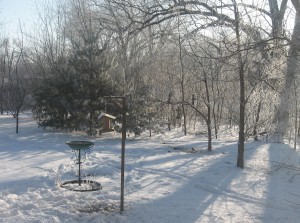
Other bird-related activities
Each year Tom conducts a Breeding Bird Survey route for the USGS’s Breeding Bird Survey project. He is a member of the Illinois Audubon Society and the Illinois Ornithological Society, and he occasionally participates in or leads birding field trips. In addition to submitting counts to eBird, Tom usually conducts several bird surveys at a variety of sites in central Illinois during the breeding season. Also, he has been doing a long-term count of overwintering Red-headed Woodpeckers at Sand Prairie-Scrub Oak Nature Preserve, in central Illinois, since 2003. He described the woodpecker research on his blog, called The River Landing. He is also the author of Side Channels: A Collection of Nature Writing and Memoir.
Read more about Tom’s FeederWatching experiences in a blog post he made in 2010. Tom described Project FeederWatch and included graphs illustrating changes he observed in the birds at his feeders during his first ten years of FeederWatching.
Young FeederWatchers
Aubrey Mitchell
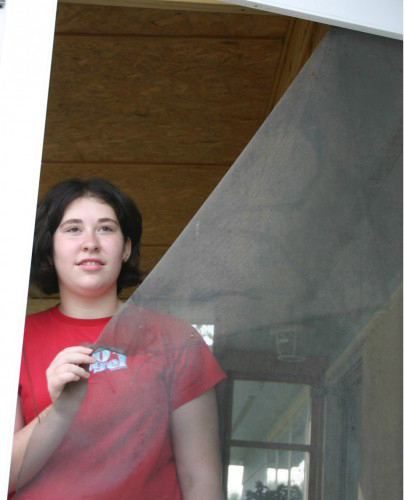
High school student Aubrey Mitchell of Augusta, Kansas, originally enrolled in Project FeederWatch as part of a 4-H project on wildlife. She put up several different types of feeders and water sources and created a brush pile to offer protection for birds visiting the feeders. As part of the project, she learned how to identify Kansas birds and made a poster about the birds that visited her feeders for the county fair.
As a result of her project, Aubrey was invited to represent her state in the wildlife category at the 2005 National 4-H Congress held in Atlanta, Georgia, during the last week of November. After returning from Atlanta, Aubrey wrote of her experience, “I went to workshops on leadership, heard many motivational speakers, and toured Atlanta. Best of all, I got to meet many different people from all of over the United States and parts of the world.”
Aubrey’s 4-H club does not have a project leader in wildlife, so most of her wildlife project was self-determined. She wrote, “Project FeederWatch taught me how to participate in something important and how to get others involved. I have gotten other 4-Hers interested in wildlife, especially birds. When I’m old enough, I will become the project leader for wildlife.”
Habitat and weather
Aubrey lives on a rural two-acre lot with mature trees, shrubs, and grasses, about 1/4 of a mile from the Whitewater River. Most of the land around her is used for farming.
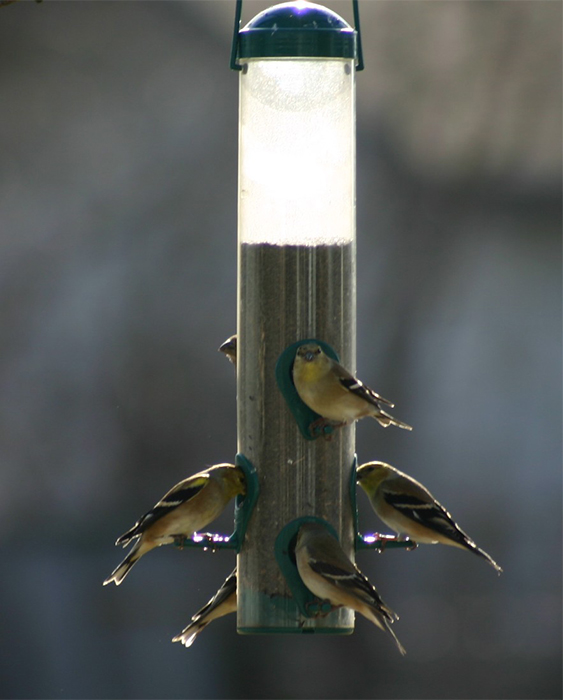
After her first season of FeederWatch, Aubrey wrote, “The best part of Project Feeder Watch was the hours of enjoyment watching the vast variety of birds that came to the feeders. Little did I know the moment I put out the feeders in my backyard that it would cease being mine. I was thrilled to play host to hordes of goldfinches and Red-winged Blackbirds. I quickly planned to participate the next season because I was hooked!”
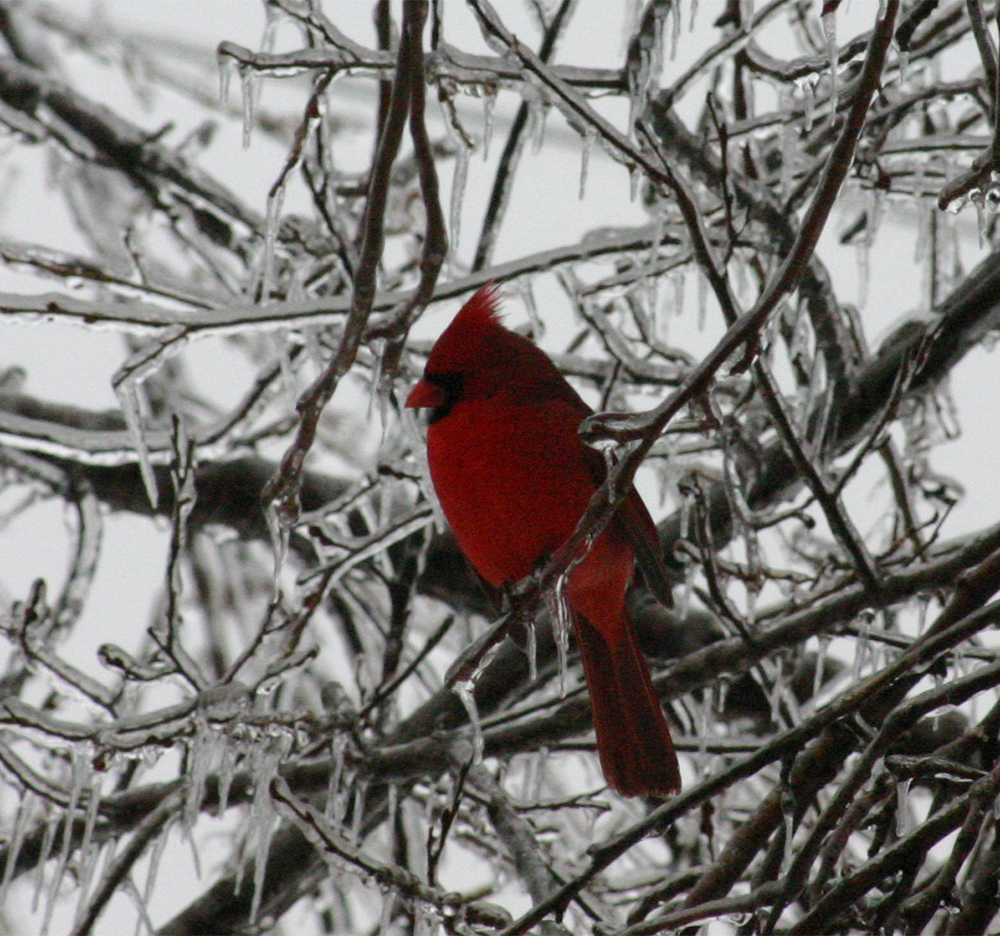
Temperatures and weather conditions fluctuate in Kansas. One week the high temperature is in the 20’s and the next week it is in the 60’s. They have rain, snow, and ice in the winter. Aubrey watches her feeders from inside the house when it is cold and from one of the family’s two screened in porches when the weather is warm.
A surprise visitor
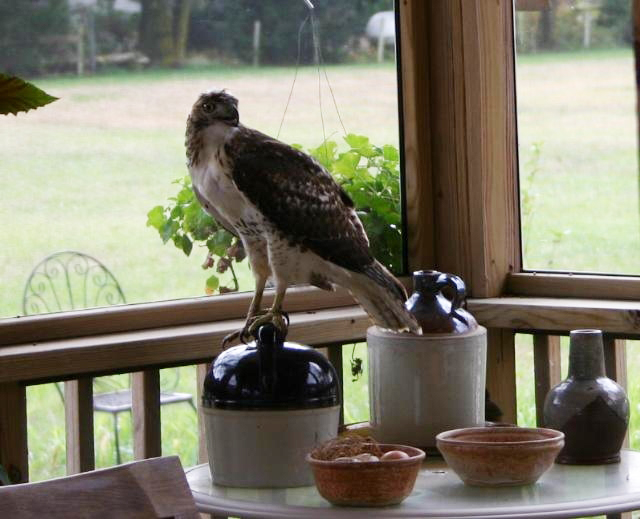
At the start of Aubrey’s second FeederWatch season, she came home to find a Red-tailed Hawk trapped in her family’s screened in deck. Apparently, the bird had snared a wild rabbit and then flew through the screen door of the deck. Eventually Aubrey and her parents managed to coax the bird outside.
Favorite bird
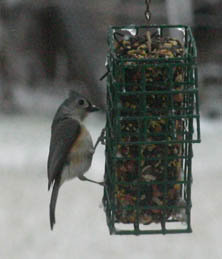
Aubrey enjoys the song of the Tufted Titmice and their feeding style. She wrote, “They perch on one of the highest branches on a tree and size up the situation. Then, the titmice dive bomb the feeders, grab one seed, and fly back up to their lofty branch. They are quick.”
Madison Griffin
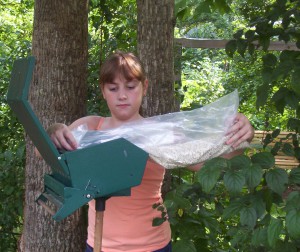
Madison is one of Project FeederWatch’s many young participants. During the 2004-2005 FeederWatch season, when Madison was 9, her mother wrote to tell us about how Madison was in charge of FeederWatch in their home. According to her mother, “Madison routinely drilled the rest of the family on bird identification.” She was always excited for the Count Days when she watched the feeders with her binoculars in hand.
Habitat
Madison lives on a partially wooded lot in a suburban area of Canton, Georgia. The yard has been certified as a Backyard Wildlife Habitat because the family grows bird-friendly plants. Madison reports that goldfinches especially love eating seeds from some of their plants. Madison also said, “We have vines outside our kitchen window and I love to watch the birds, especially the chickadees swing on the vines.” Last winter Madison and her mother gathered some things they had grown–dried corn, sunflowers, and peanuts–into a bird feed mix. Madison gave the mix out at Christmas so that other people could feed the birds.
Feeder Visitors
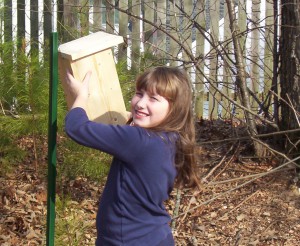
During the FeederWatch season Madison and her family watch their feeders in the morning and late afternoon when the birds are most active. The birds that visit their feeders include chickadees, Brown-headed Nuthatches, cardinals, and House Finches. Madison enjoys the cardinals best because, “their bright red color is so pretty in winter.” Once an Indigo Bunting visited, which caused some excitement as the family consulted a field guide to verify their identification.
Last year there was some development behind her house that involved cutting down some trees. During that time they didn’t see their Brown-headed Nuthatches and were very upset that their nests were likely destroyed. But about three weeks later the nuthatches came back, much to the family’s relief.
Helping local birds
Madison completed her Girl Scout Bronze Award project last year by working on a bluebird habitat at her church’s cemetery. Madison and her father built birdhouses and researched the best place to install them.
Marianna B
Birding From an Early Age

Marianna B (last name withheld to protect Marianna) has been participating in Project FeederWatch since she was 8 years old and has designated herself as a “Preventer of Extinction.” According to Marianna’s mother, Erin, “Marianna has had a manifest love of the natural world since she was an infant.” Her interest in birds began at age 6 when her parents installed a feeder outside her bedroom window. When Marianna was eight, she monitored a pair of ospreys throughout their breeding cycle via a live streaming cam and began a self-directed research journey through conservation, ecology, avian anatomy, and bird identification, reading books by Rachel Carson, David Sibley, and Donald and Lillian Stokes, to name a few. Later that same year, she founded her own Wildlife Research Center (WRC), “diligently keeping tabs on the health, breeding patterns, and seasonal shifts of her backyard birds,” according to Erin. For Marianna, “FeederWatching is about more than just birds; it’s about the whole future of the planet,” said her mother.
FeederWatching

Marianna counts for FeederWatch with her father, James, who shared that he enjoys seeing Marianna’s “passion, enthusiasm, and knowledge in action” when they FeederWatch together. Marianna says that she loves everything about participating but especially, counting with Papa and seeing all the different birds.
FeederWatching highlights have included seeing new birds, like a Pine Siskin, and seeing a flock of 100 Red-winged Blackbirds and grackles and the chaos they caused when they invaded the feeders with their noisy chatter. Marianna always enjoys seeing birds that rarely visit her count site, like jays, robins, crows, and hawks. But she doesn’t like it when the birds go away. She’s seen lots of cats scaring birds and reported that in 2021 they had 40 Chipping Sparrows visiting, but in 2023 there were only eleven.
Favorite Birds and Inspiration

Marianna loves to see kinglets, bluebirds, and Cedar Waxwing, but Prothonotary Warbler, Carolina Chickadee, Carolina Wren, Red-shouldered Hawk, and Ruby-crowned Kinglet are her favorites. Marianna says, “I love everything about birds. They’re smart and come in so many varieties. They inspire me to be a better person, and they inspired me to run the WRC! Birds help people become more interested in nature and inspire them to be more caring. Birds are available to everyone, and they connect us to each other—they bring people together.”
Wildlife Resource Center

Marianna’s Wildlife Research Center is having an impact by making people aware and encouraging them to appreciate creatures like vultures, owls, alligators. She is also working to help ecosystems. As she says, “we help grow populations…like plants—bugs—birds—hawks: a foodchain!” She is dismayed by the impacts of human-caused climate change and habitat loss but believes everyone can help by participating in projects like FeederWatch to help scientists monitor populations changes. “So many birds, amphibians, turtles, mammals are endangered. Vultures are disappearing in Africa and India. So much is happening so fast, in such quantity. I want to be a good example of caring.”
Poem Excerpt
Lines from a poem Marianna wrote when she was 9, about the joy of the grackle’s return.
A summer’s day passes, and Autumn’s
On its way, oh,
How I long for you!
Then, swoop! Sweet as your flight,
You come, the glistening shine of your coat,
The iridescent violet, the brown,
The azure’s everlasting glow…
The Joy, mingled with hope.”
Olivia Gallagher
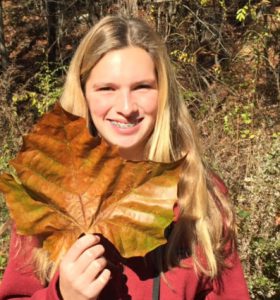
At only thirteen years-old, Olivia Gallagher of Sussex County, New Jersey, is putting together a resume to inspire birders of all ages. While Olivia is a self-described “nature-lover,” birds are her sweet spot. She wrote, “I decided to focus my interest mainly on birds because they are so diverse and interesting.” Olivia’s science teacher recognized her passion and introduced Olivia to Project FeederWatch.
Feeder Birds & Tips to Attract Them
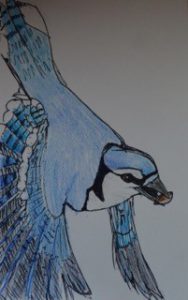
Using the FeederWatch Common Feeder Birds interactive, Olivia was able to determine the food and feeder preferences of the birds that visit her count site. The research paid off and her count site is quite diverse! During the 2015-16 season her count site hosted 20 different species and so far this season (2016-17), she has reported 17 different species.
Her favorite feeder bird is the Red-breasted Nuthatch. She described, “The nuthatches are so fun to watch, and this year was the first time they came to our feeders.” Her most common feeder bird is the Black-capped Chickadee. More uncommon visitors include Purple Finches, Pine Siskins, and White-crowned and Fox sparrows.
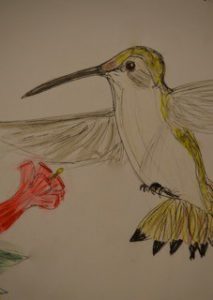
Olivia shared a few tips to create a bird-friendly count site. “In the winter it’s nice to put out a tree by the feeders for cover, and a constant supply of water in the winter is much appreciated by the birds. We use our Christmas tree after the holidays to act as a landing area and suet holder. Santa also brought a birdbath water warmer,” wrote Olivia. In the summer, Ruby-throated Hummingbirds are attracted to her yard because Olivia and her family planted an array of flowers to supplement the nectar feeders.
Living on a lake, Olivia can observe many non-feeder birds as well. She commonly sees Mallards, Hooded Mergansers, Buffleheads, cormorants, and the occasional Bald Eagle.
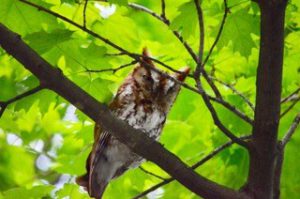
Community Involvement
With FeederWatch as her springboard, Olivia jumped headlong into the world of birds. Currently she is taking the Bird Academy’s online course that accompanies the Cornell Lab’s textbook Handbook of Bird Biology. Olivia volunteers at the Avian Wildlife Center, and as a member of her school’s environmental club, she is installing nest boxes for bluebirds and screech-owls. In addition, Olivia is a budding artist. She sketches and photographs many of her feeder visitors.
Olivia visited the Cornell Lab and had the opportunity to bird at Sapsucker Woods. On her hike she saw many waterfowl like Common and Hooded mergansers. She also had the chance to see our FeederWatch cam, which she wrote, “…was also cool since I check it every day on my computer when I am far away back at home. It was an awesome trip!”
